The Germanic languages Alphabets, Vocabula ry and semantics
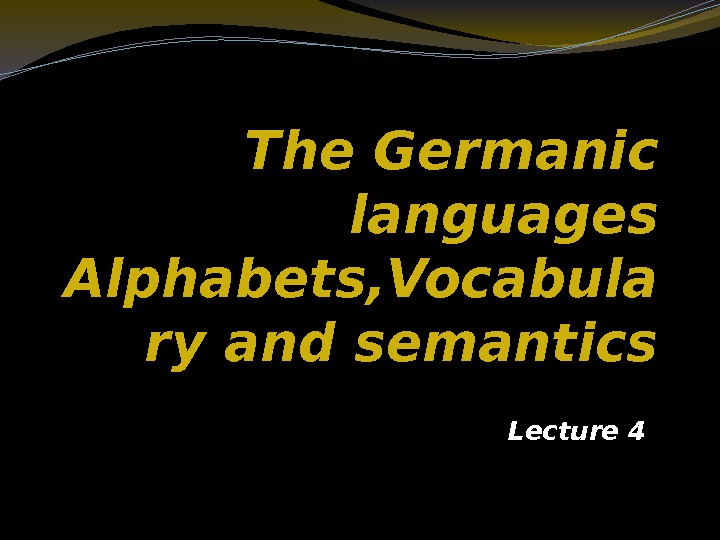
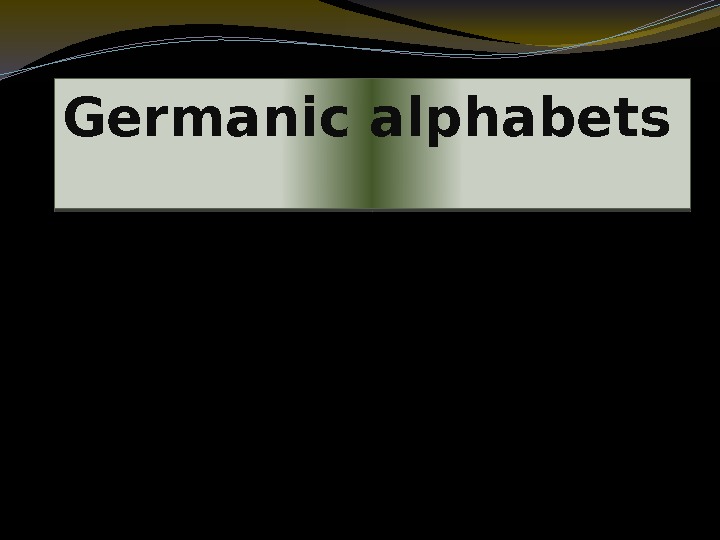
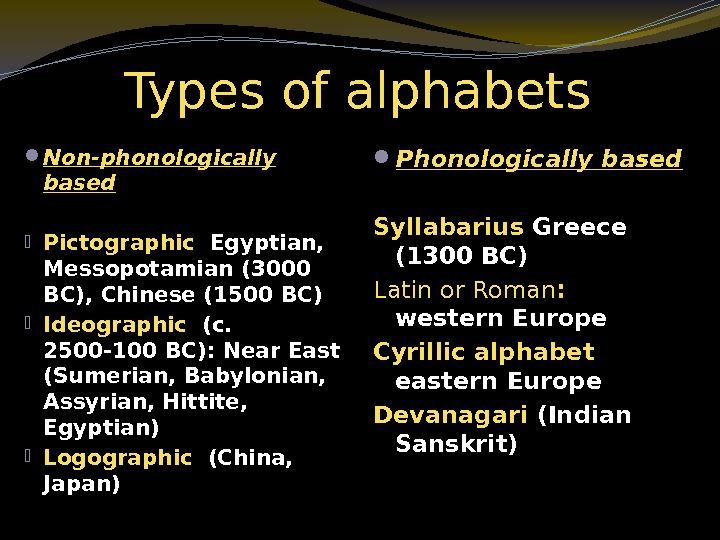
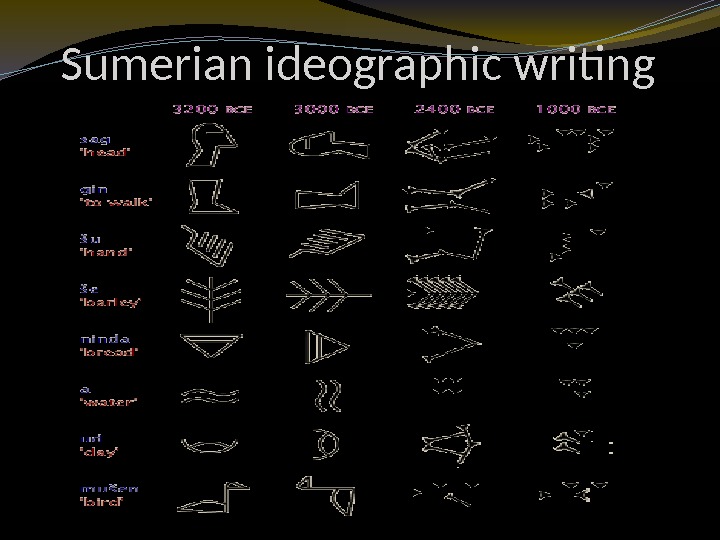
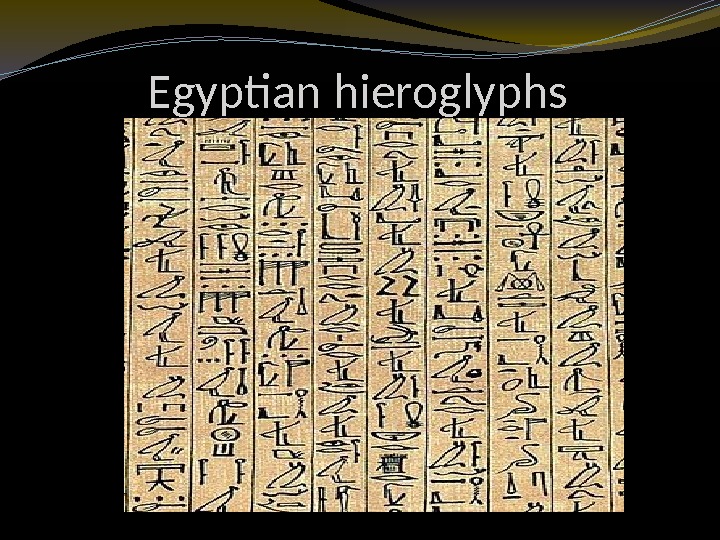
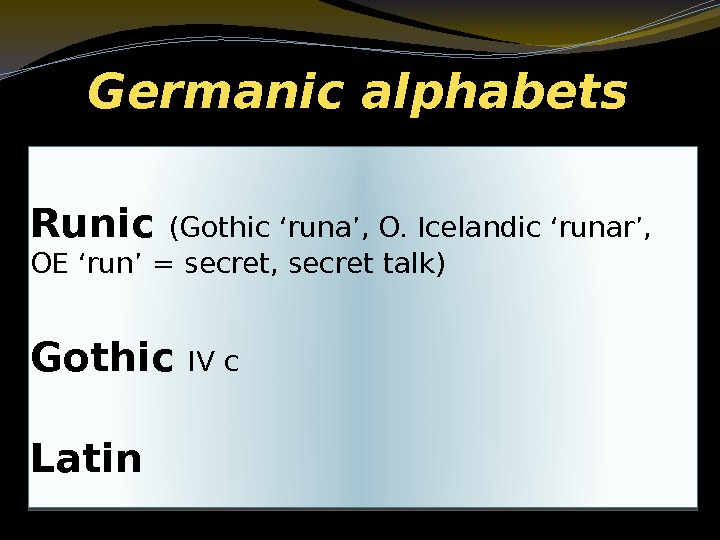
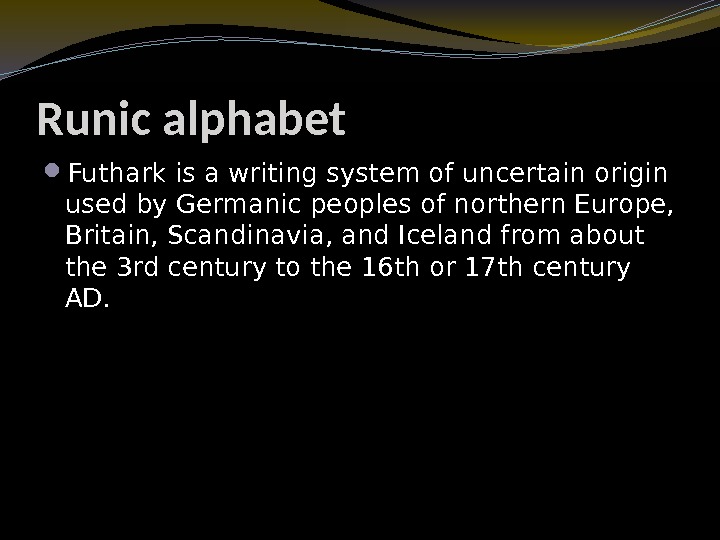
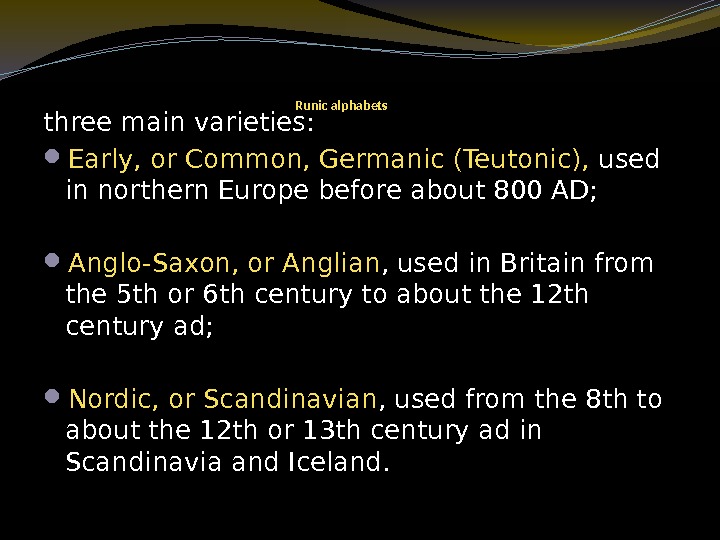
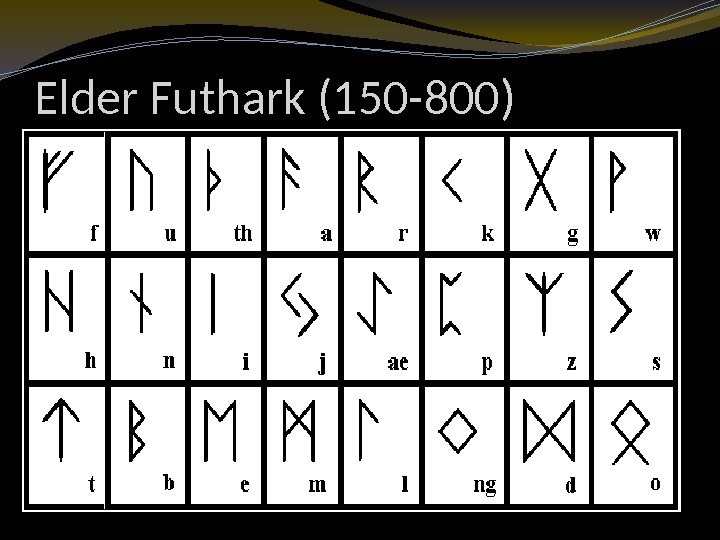
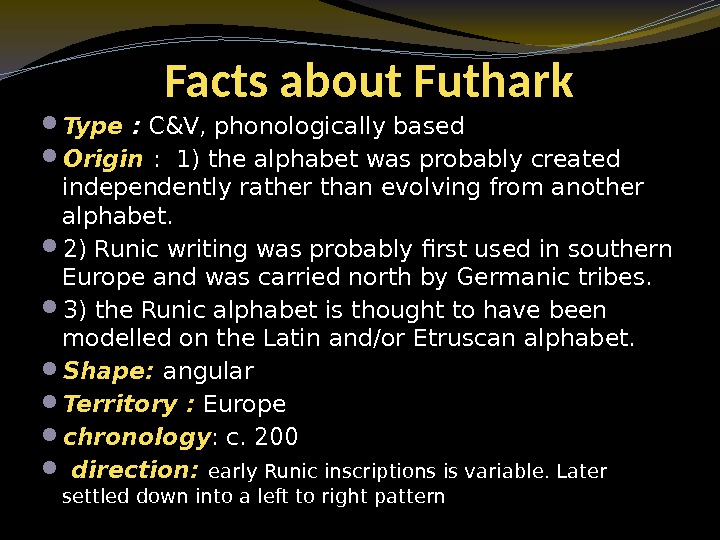
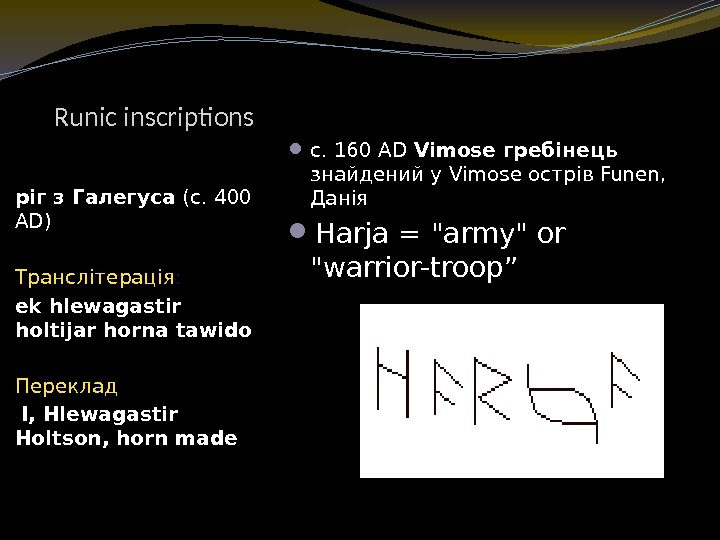
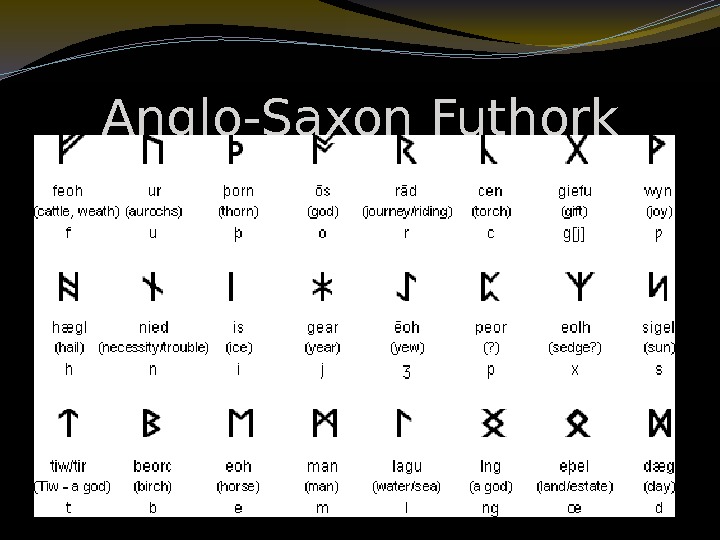
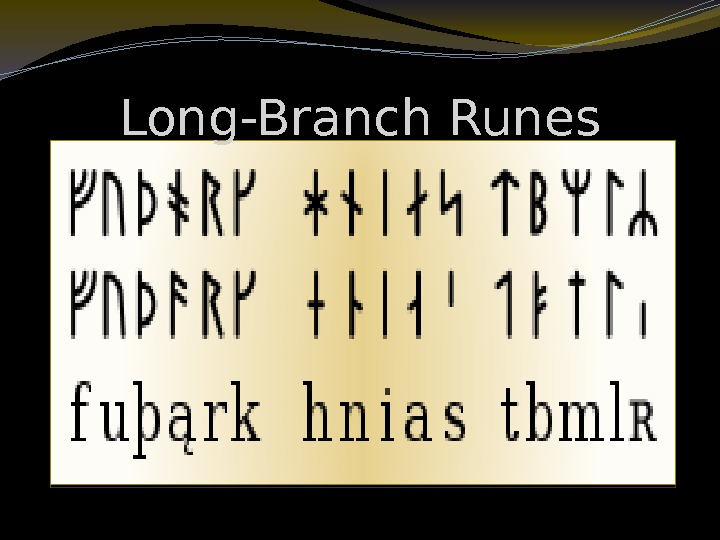
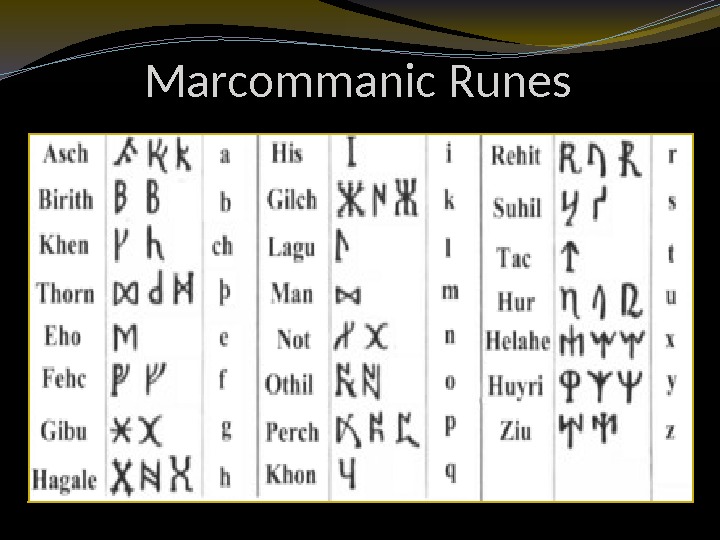
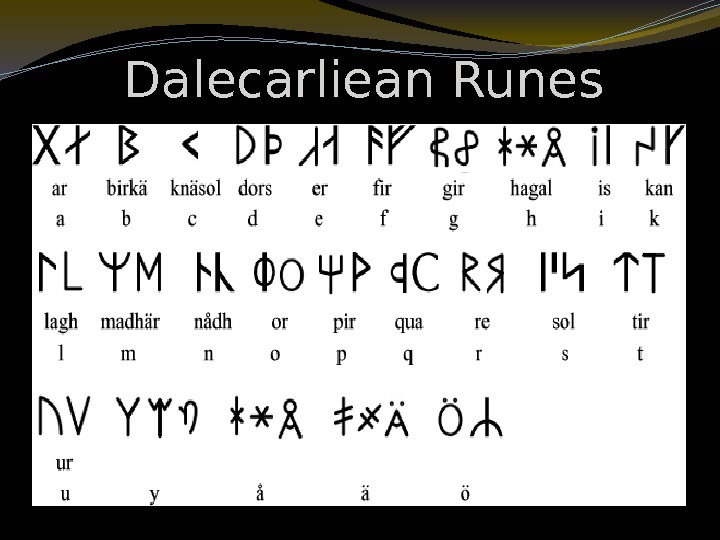
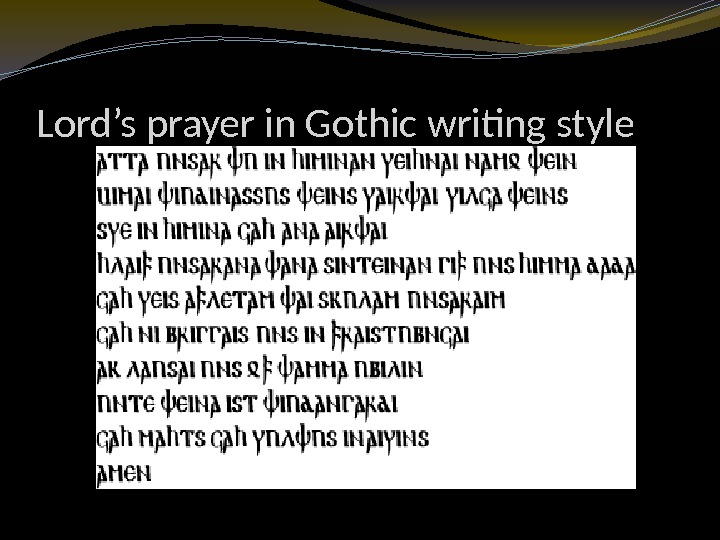
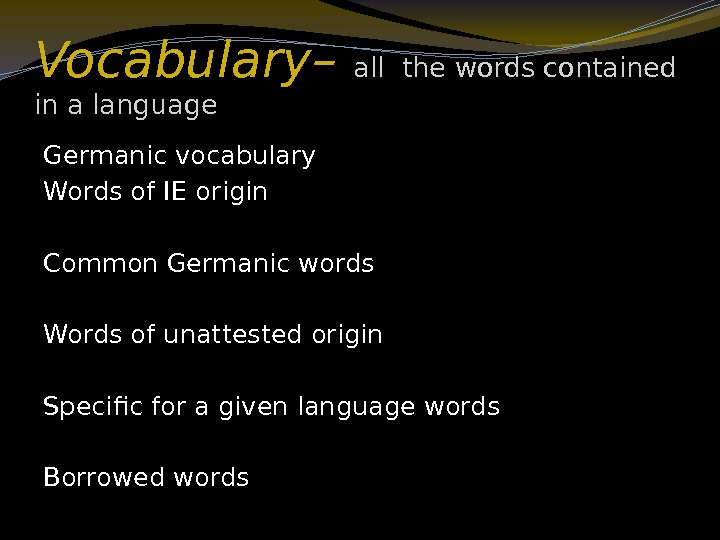
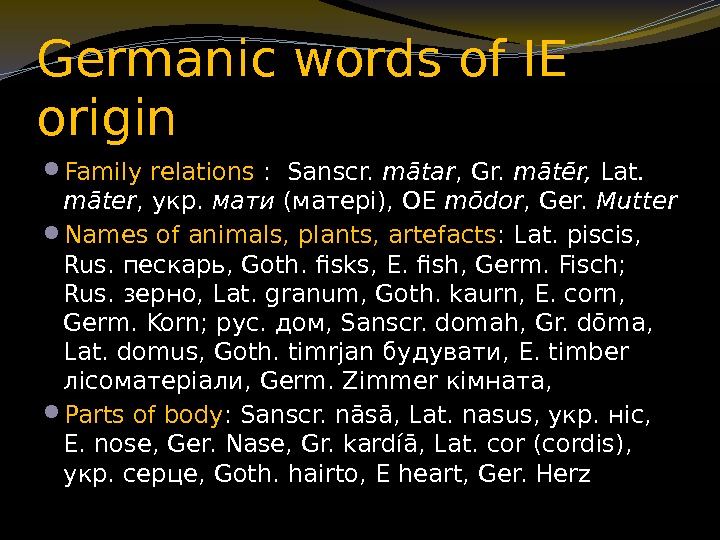
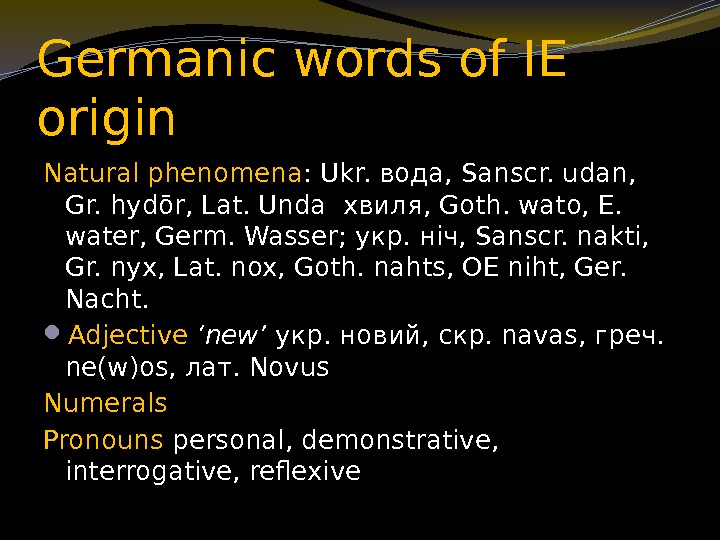
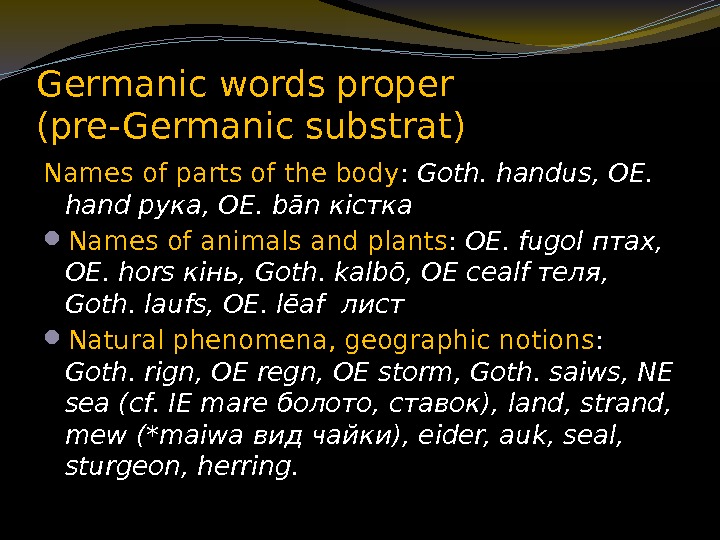
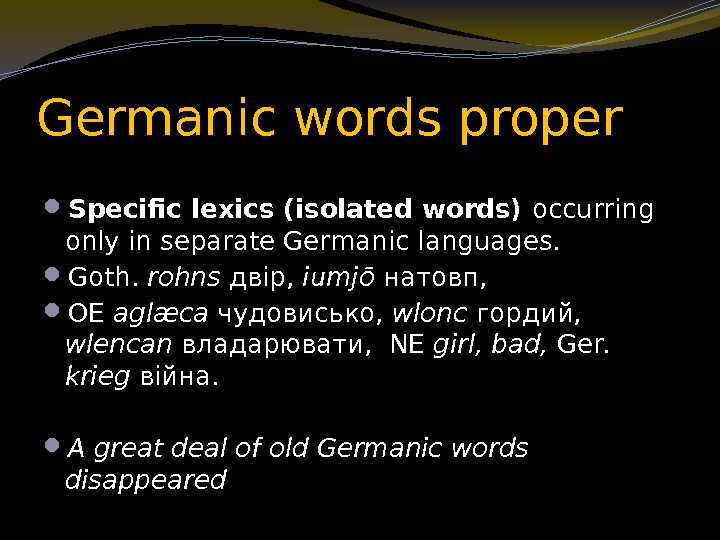
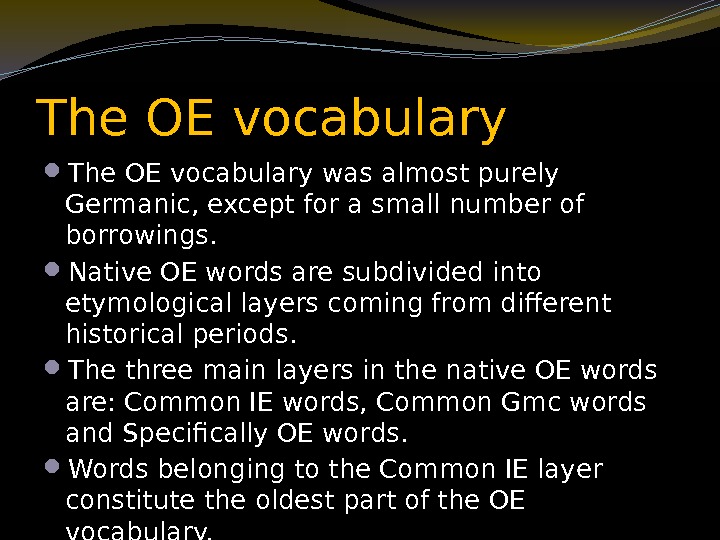
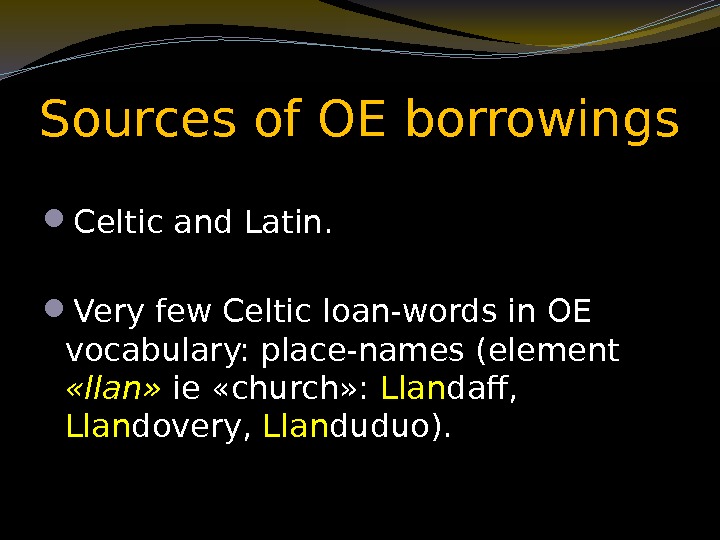
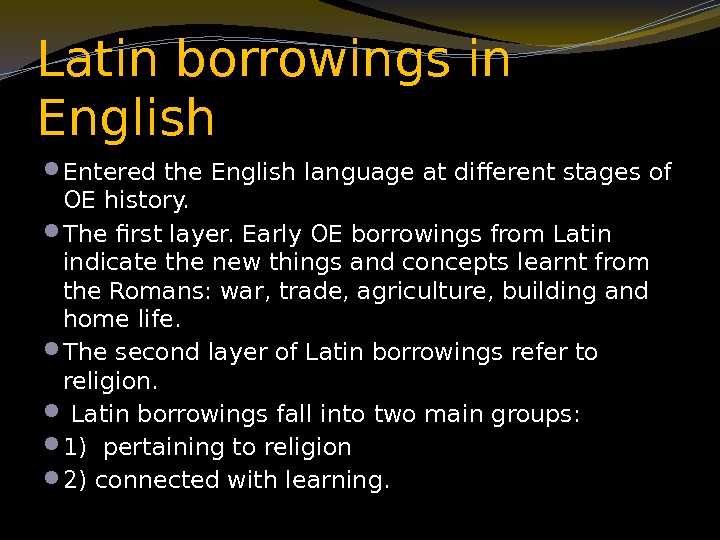
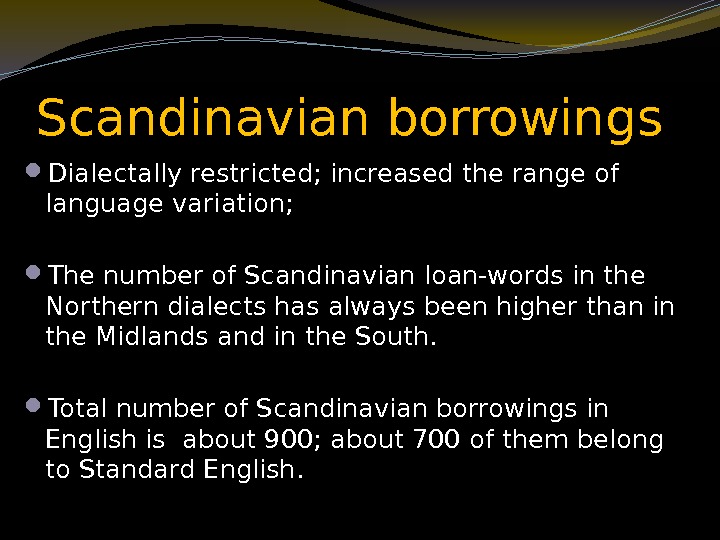
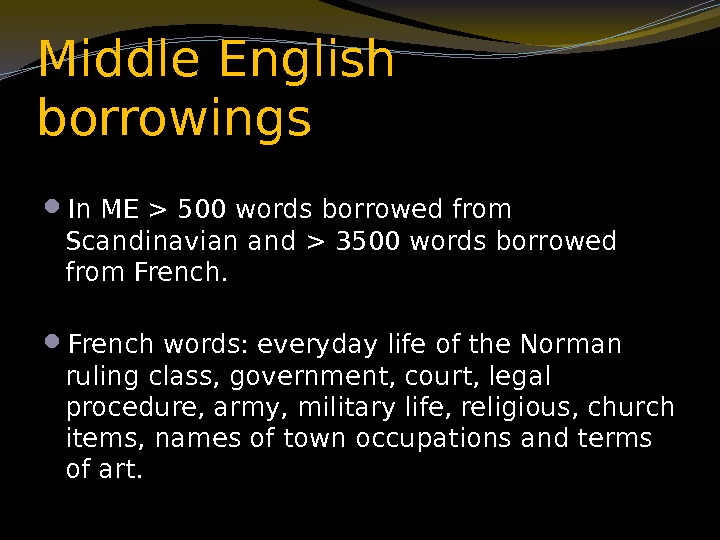
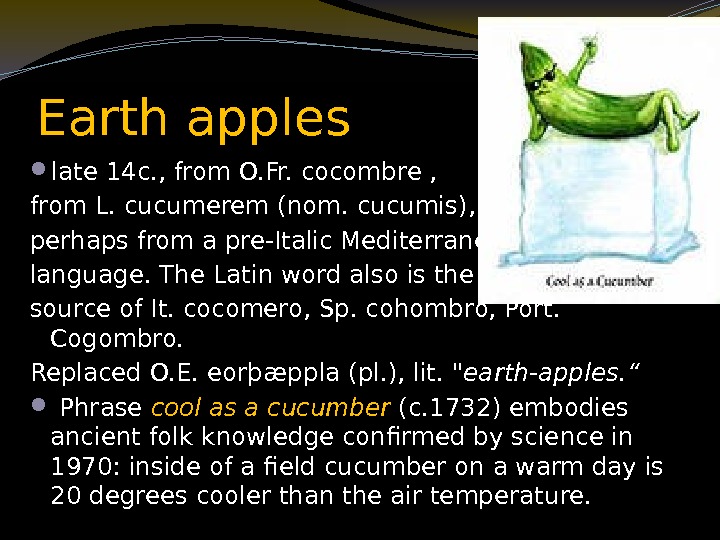
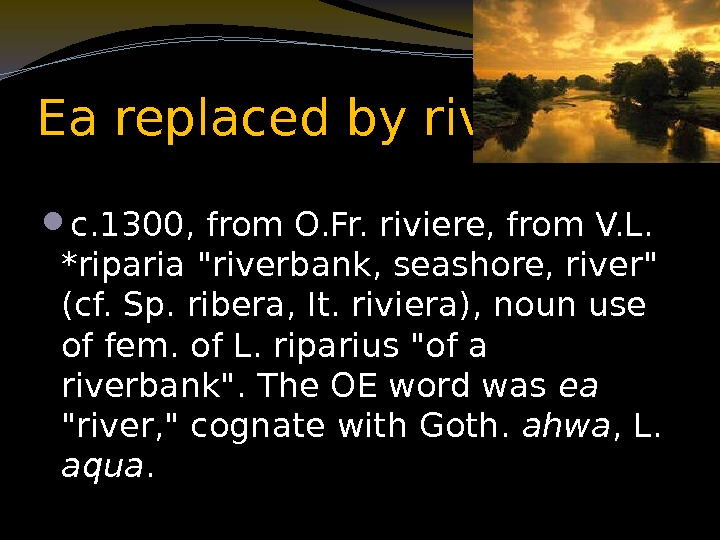
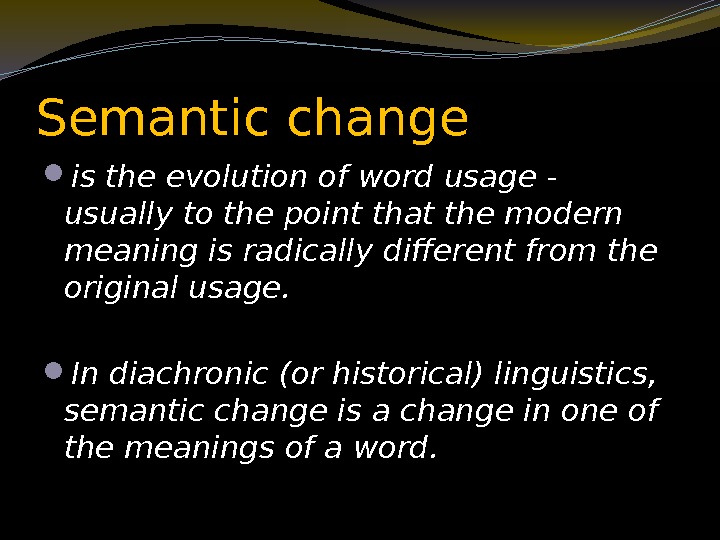
![The unpredictability of semantic change [I]n the majority of cases semantic change is as The unpredictability of semantic change [I]n the majority of cases semantic change is as](http://present5.com/presentbyword/20161216/germ_4_1_images/germ_4_1_29.jpg)
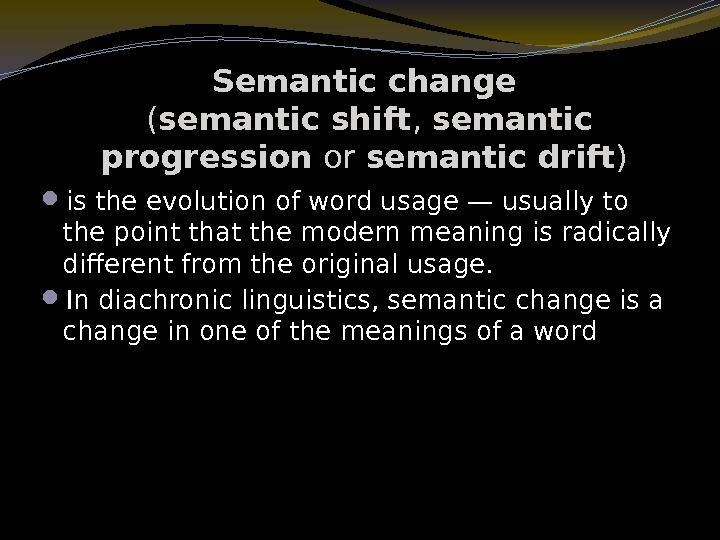
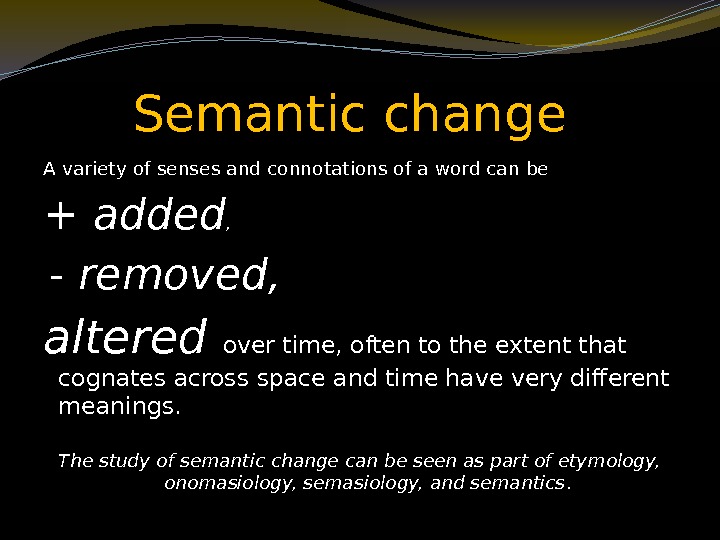
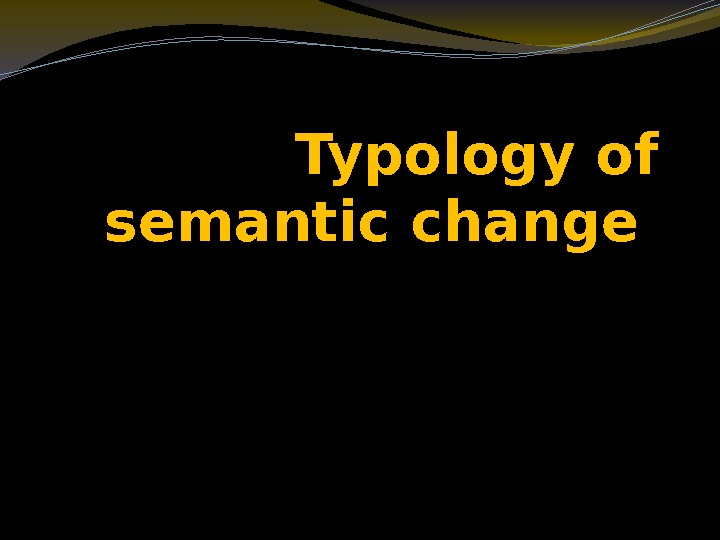
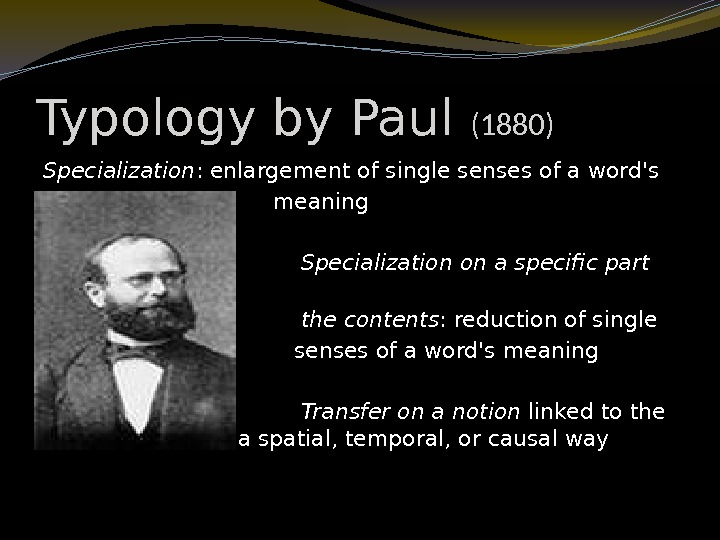
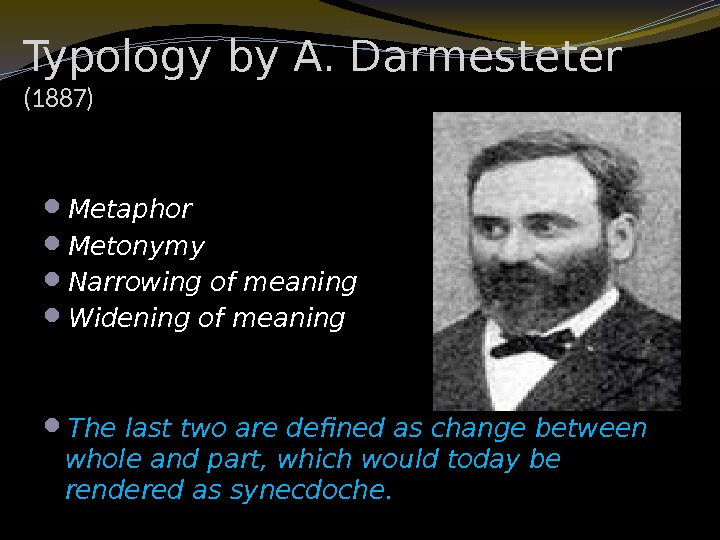
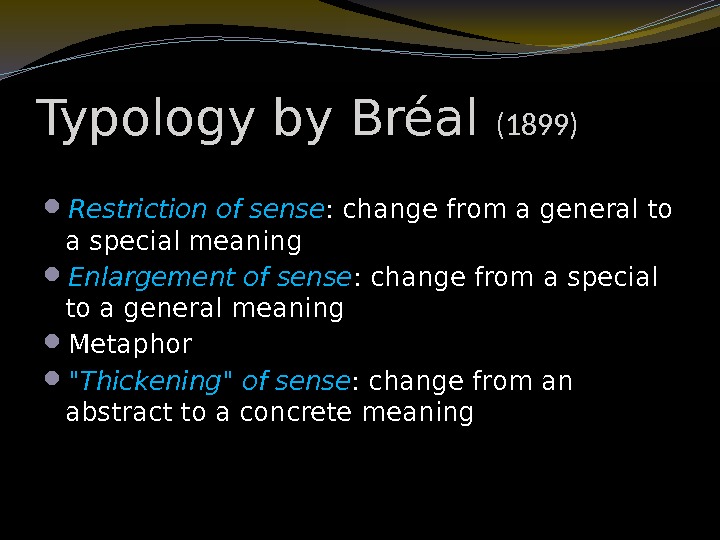
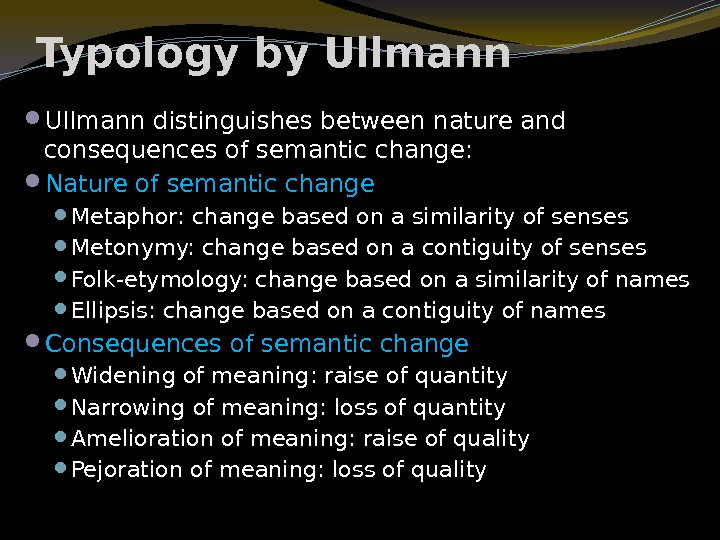
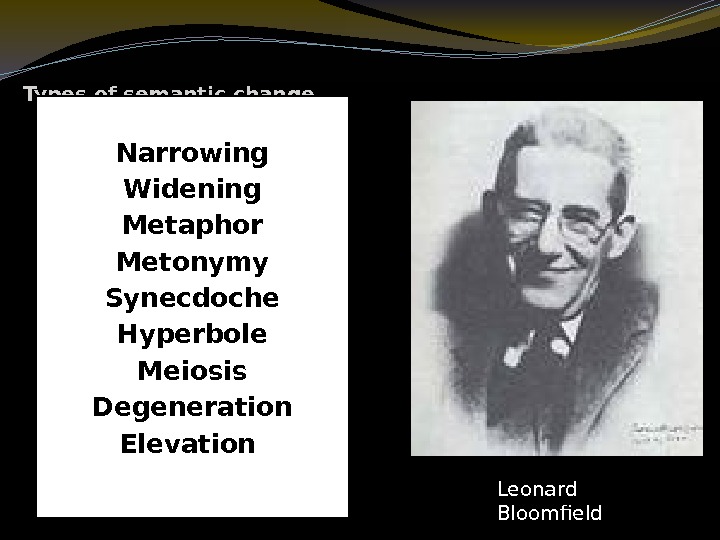
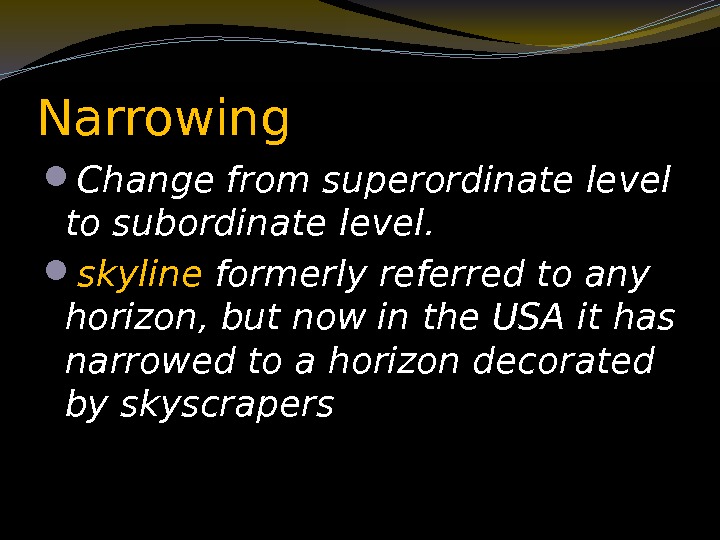
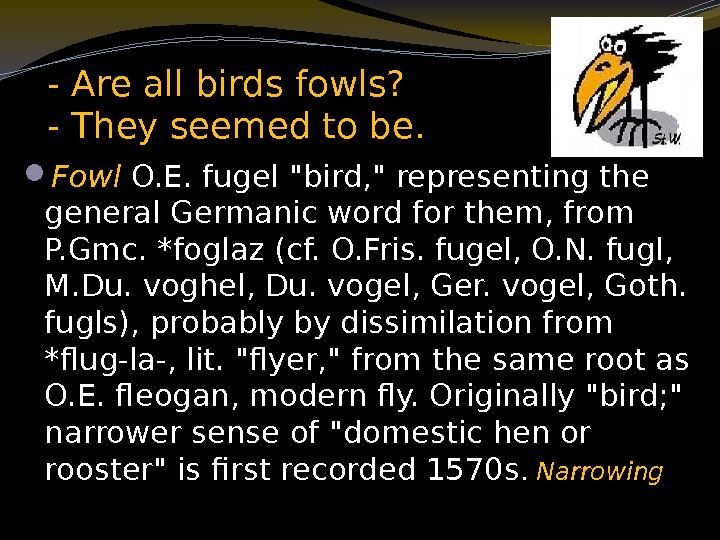
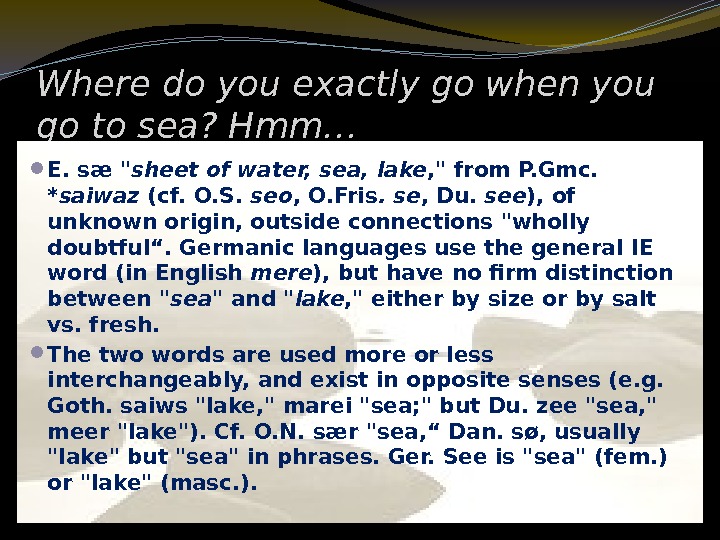
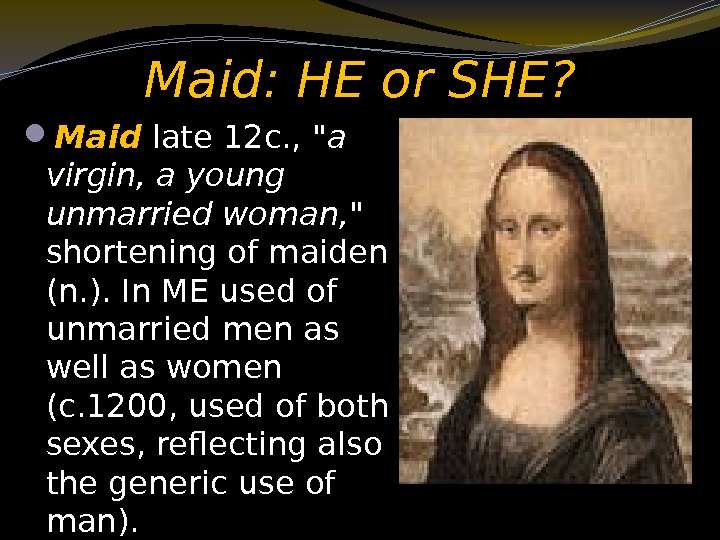
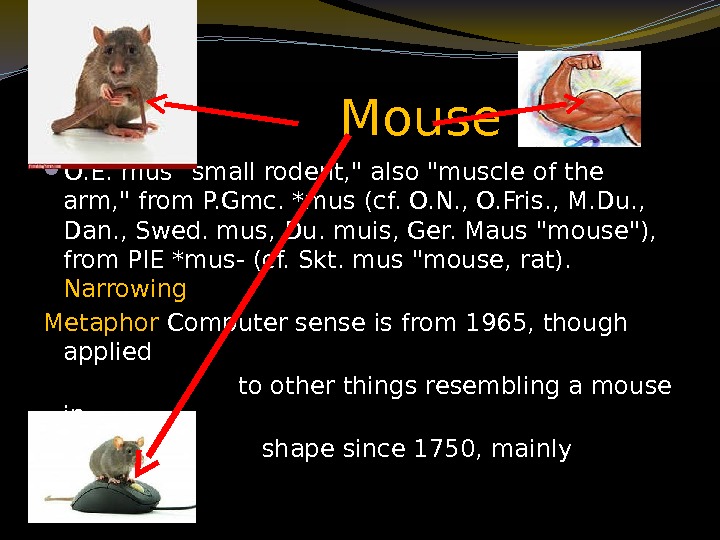
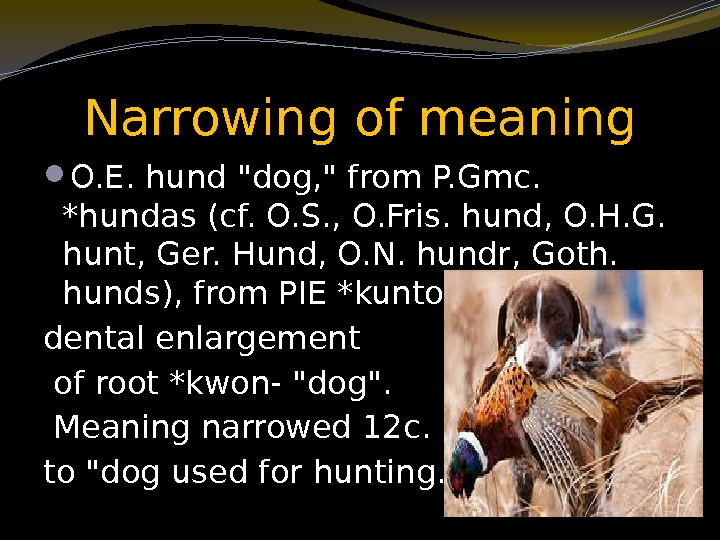
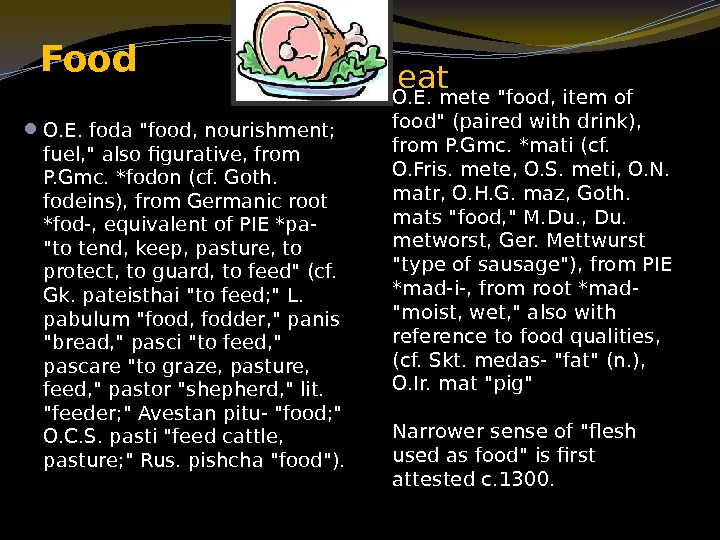
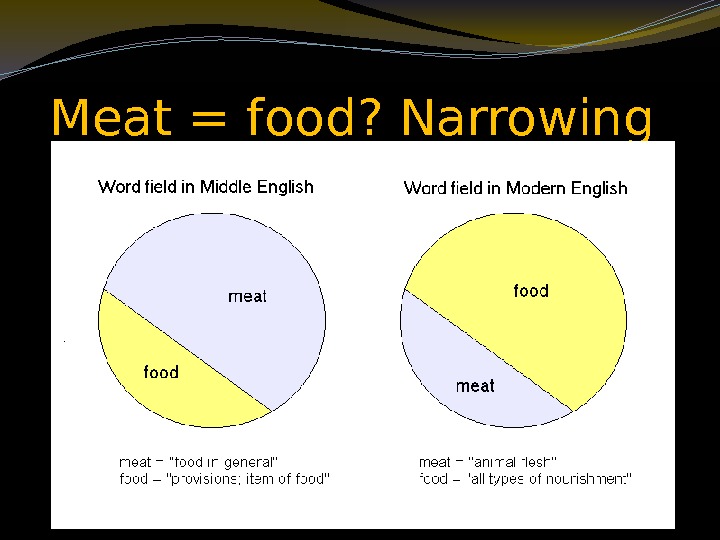
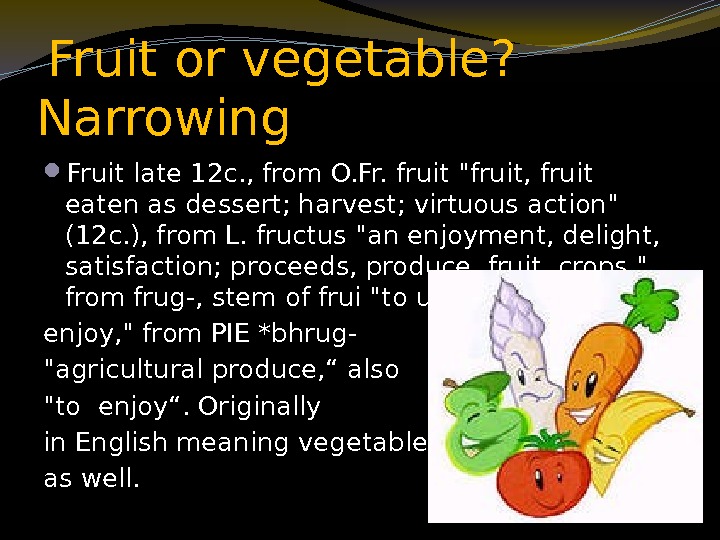
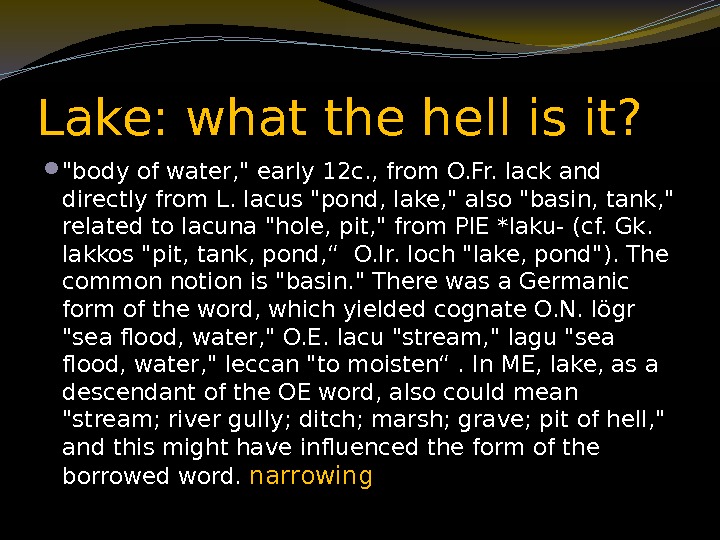
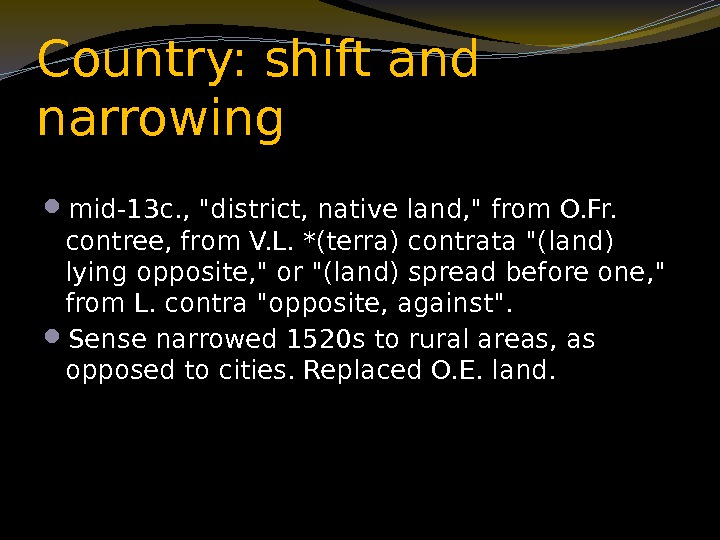
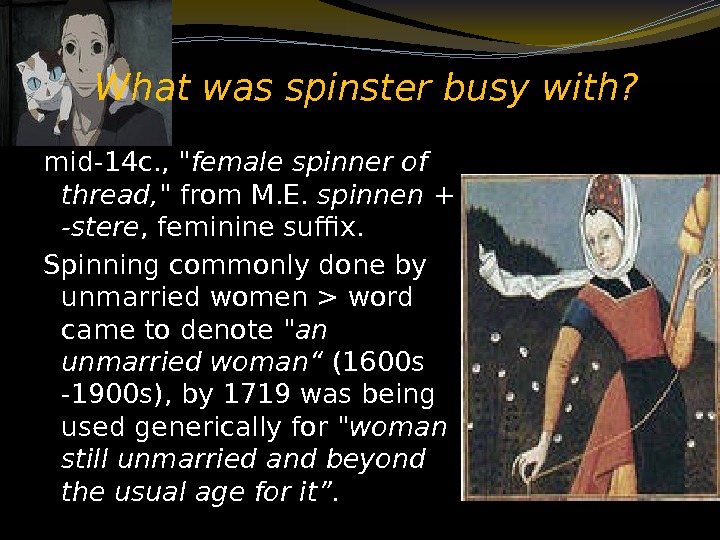
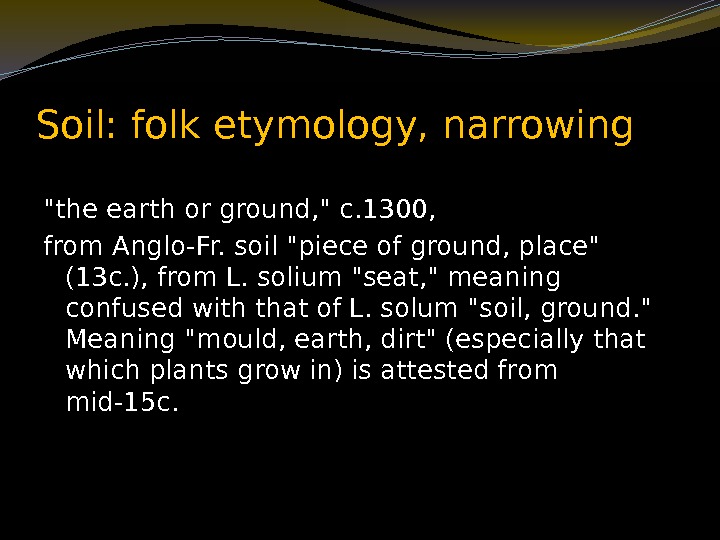
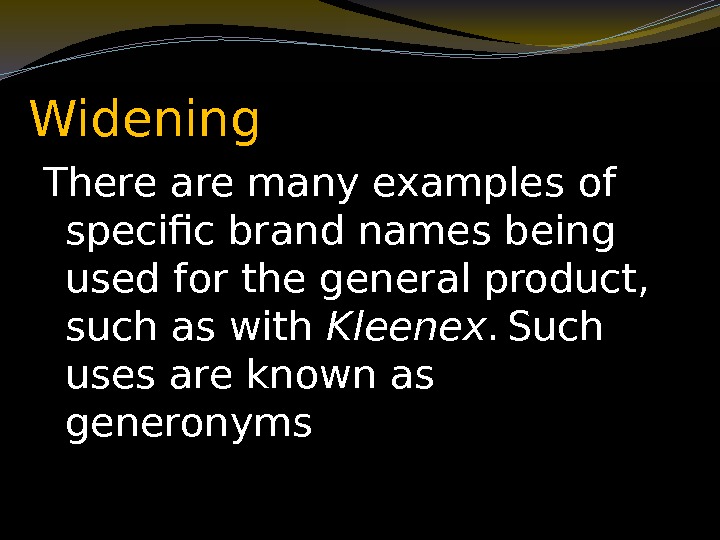
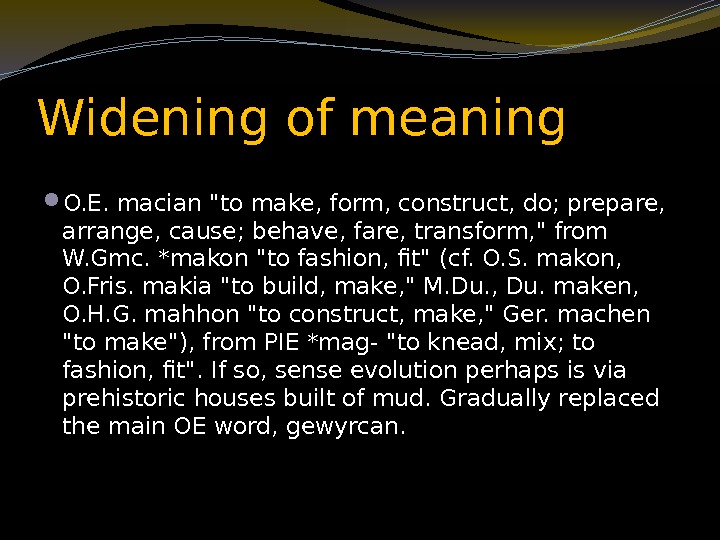
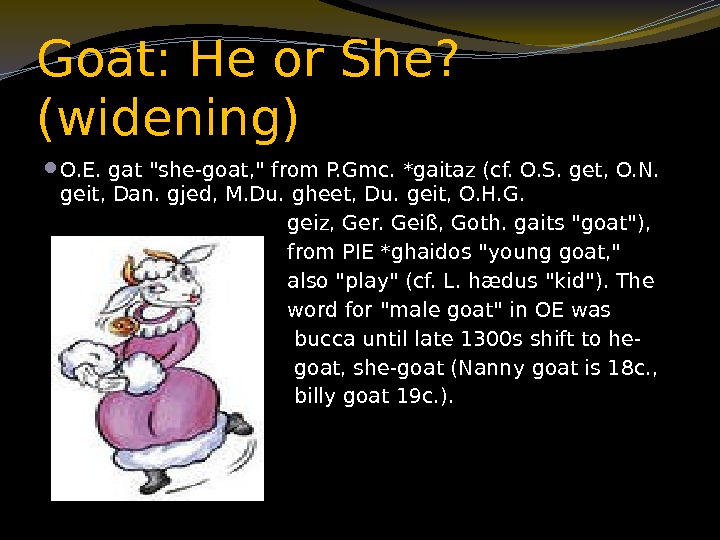
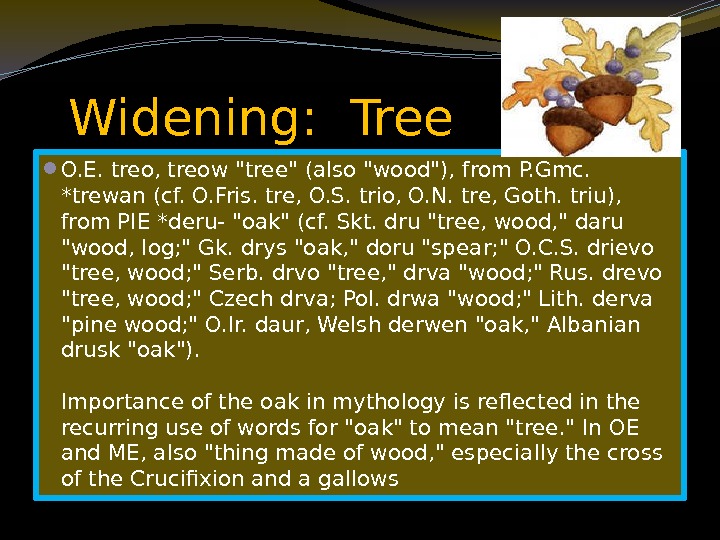
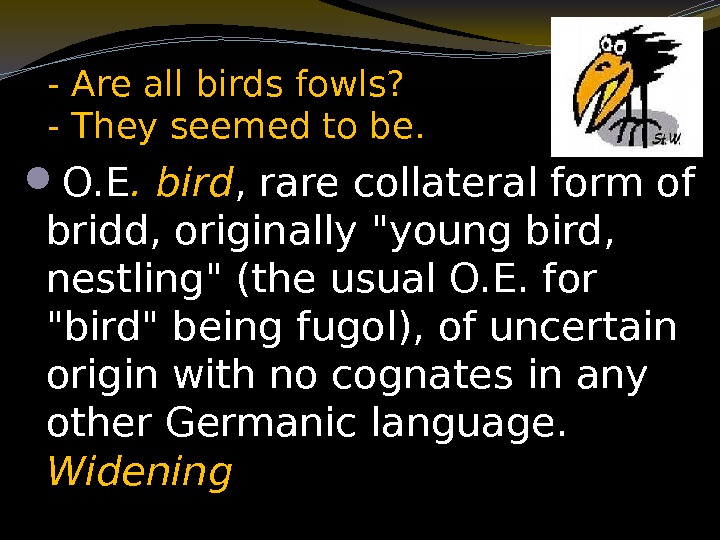
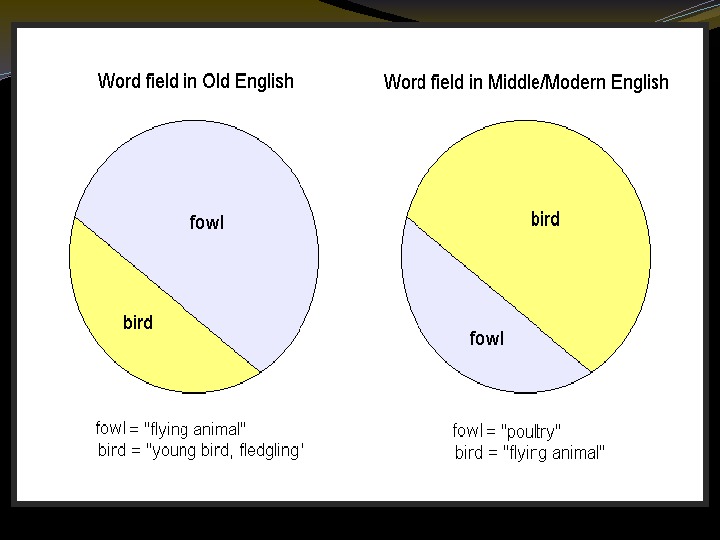
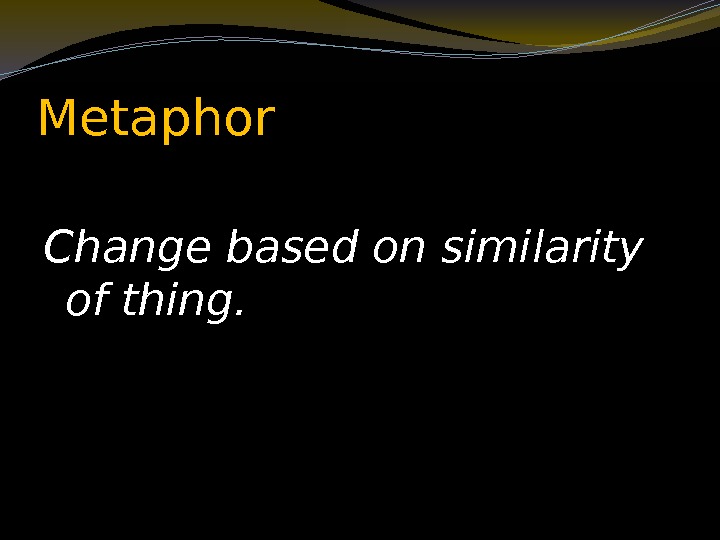
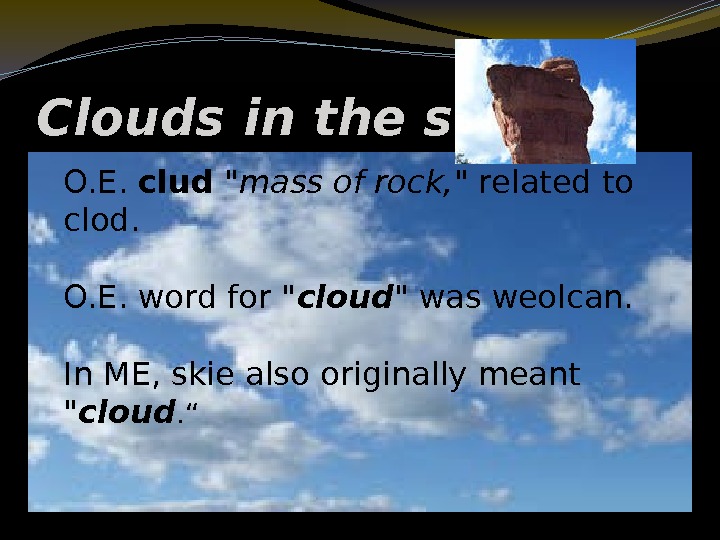
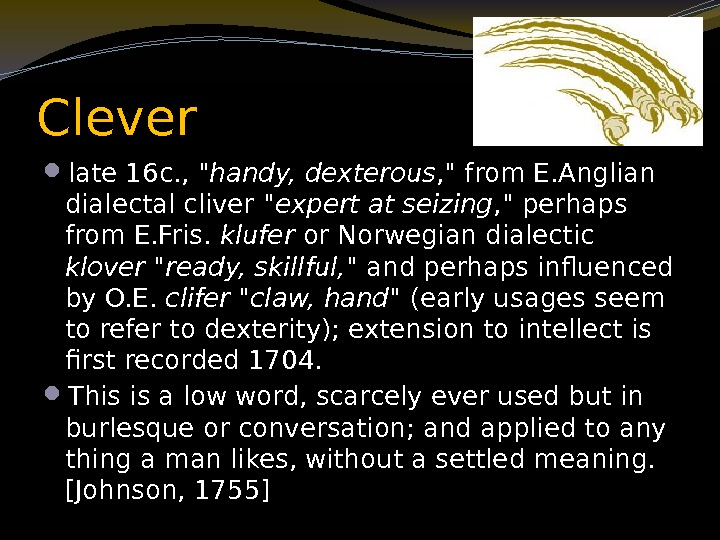
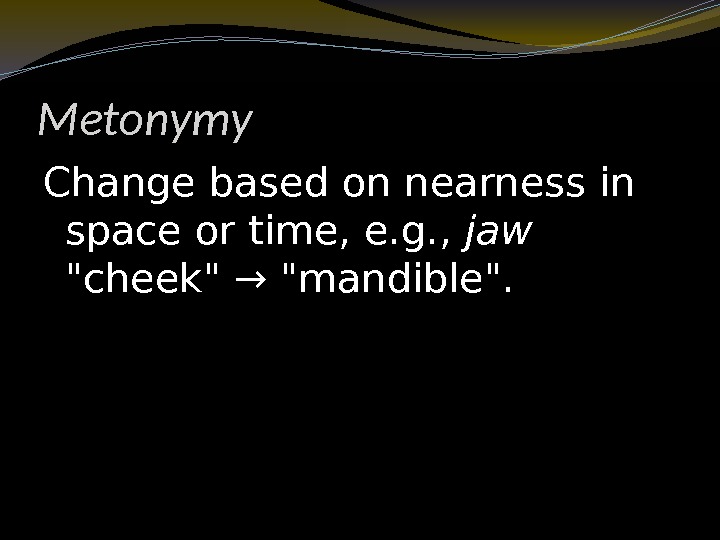
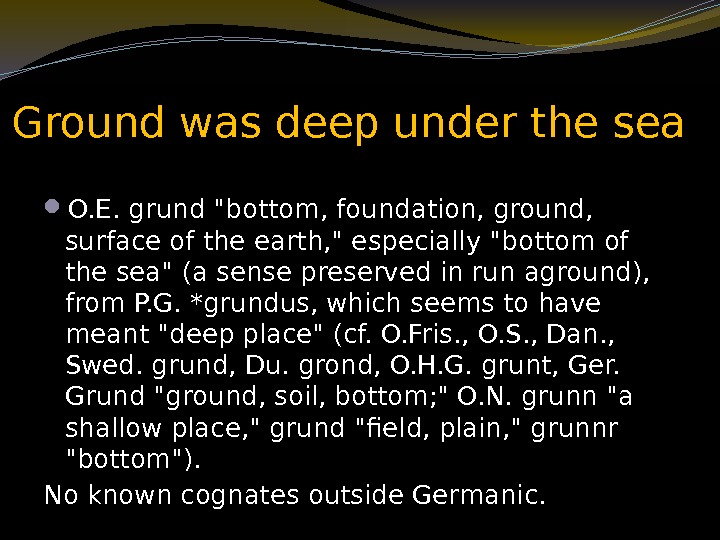
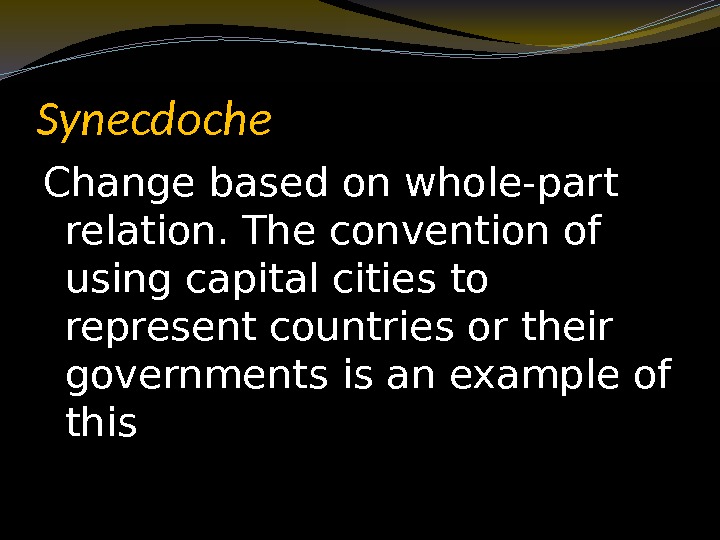
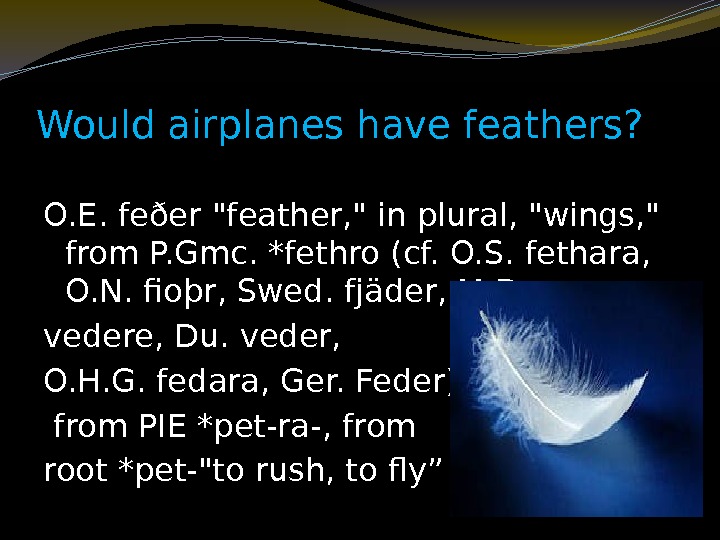
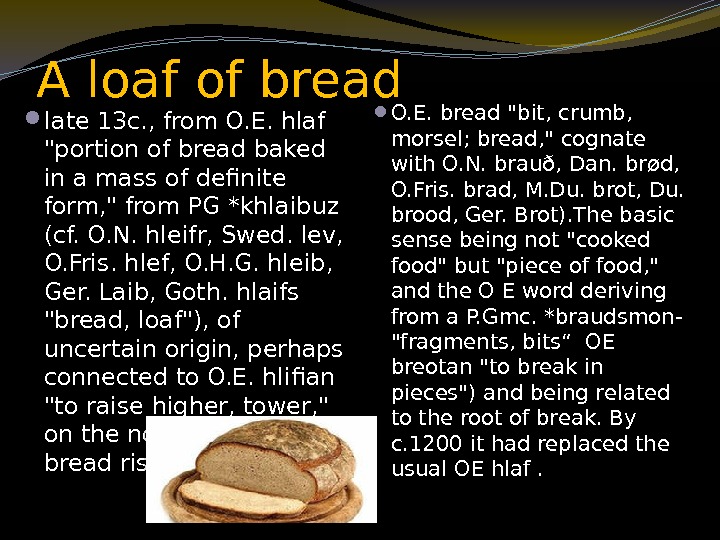
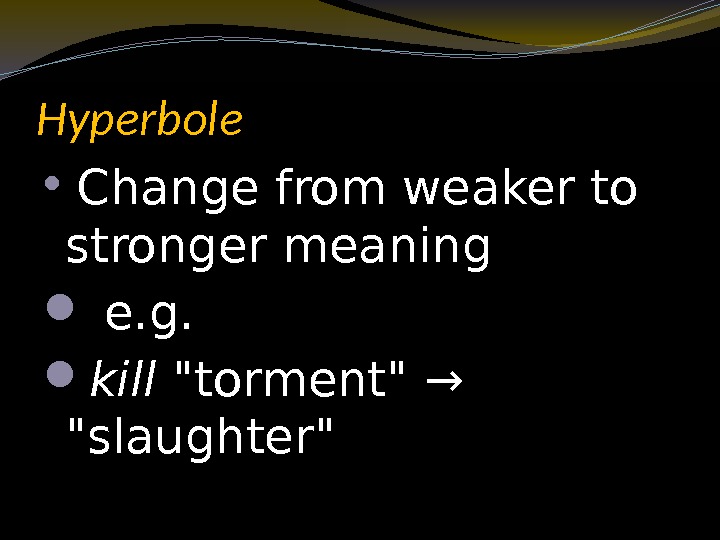
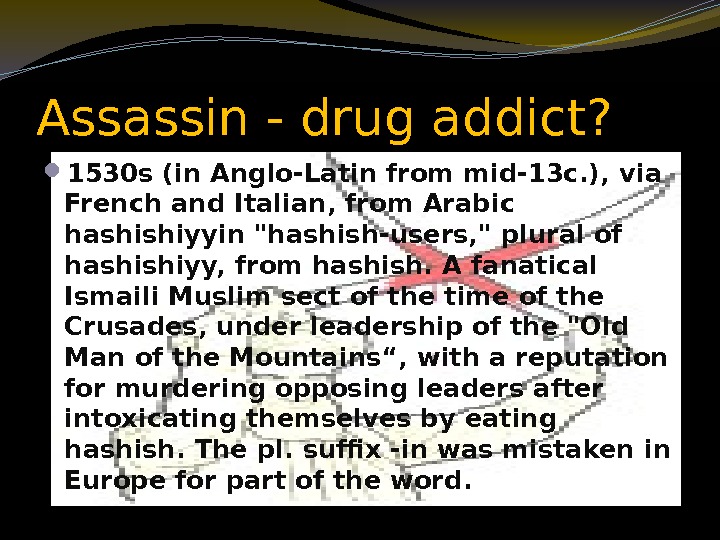
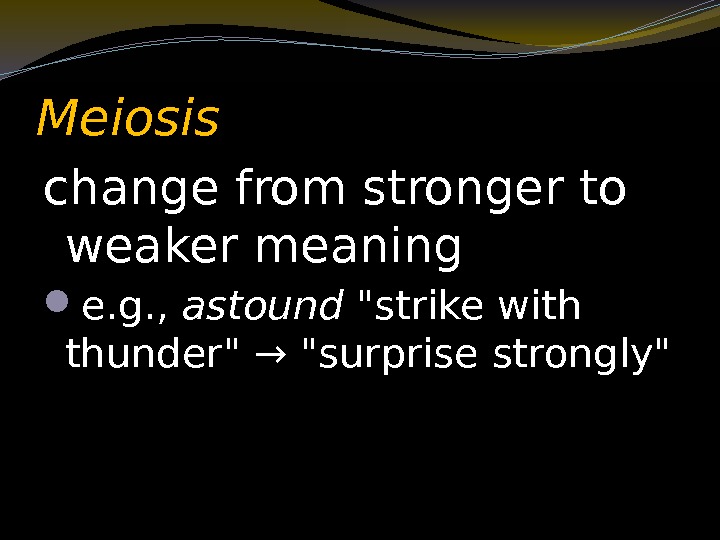
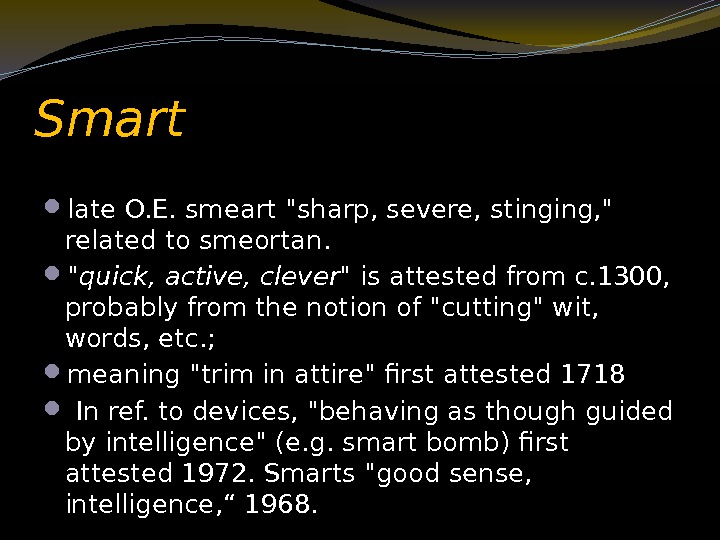
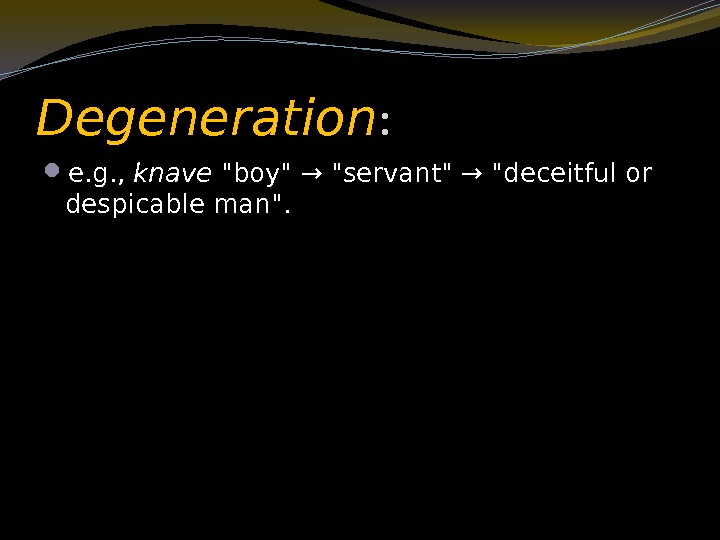
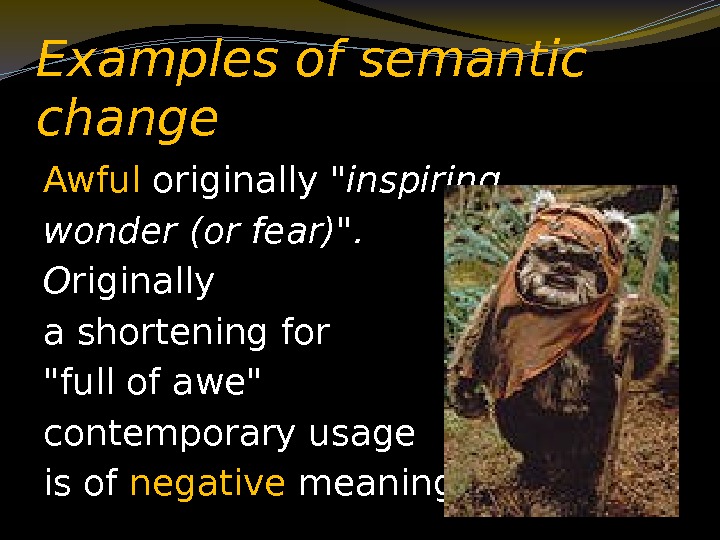
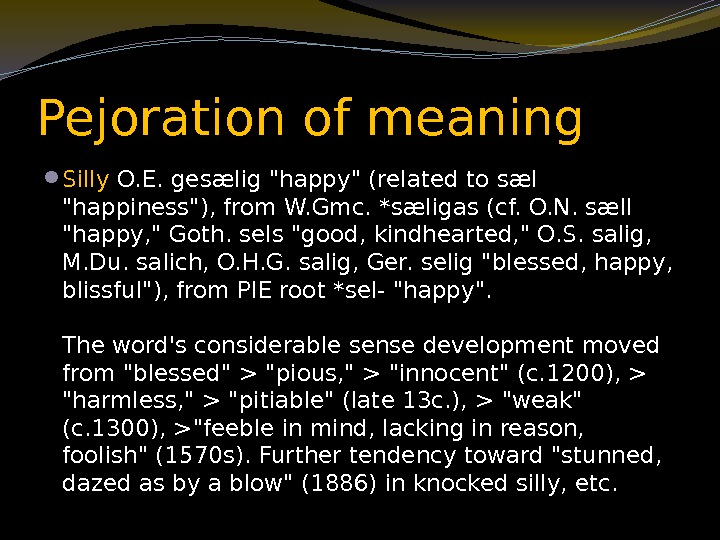
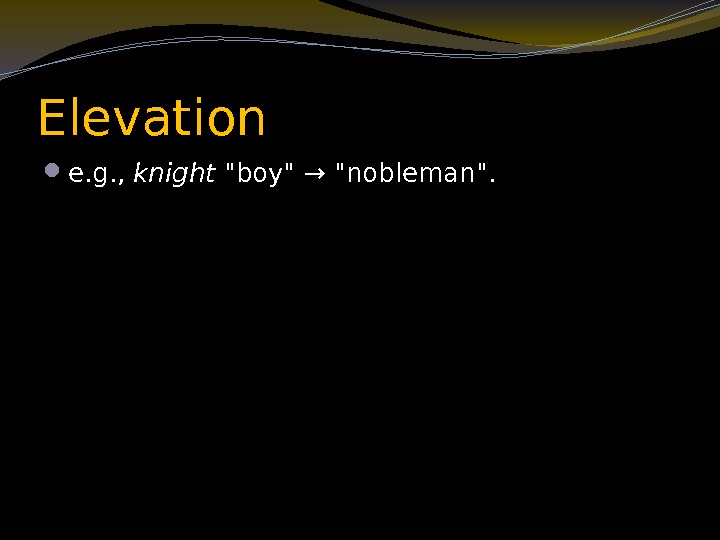
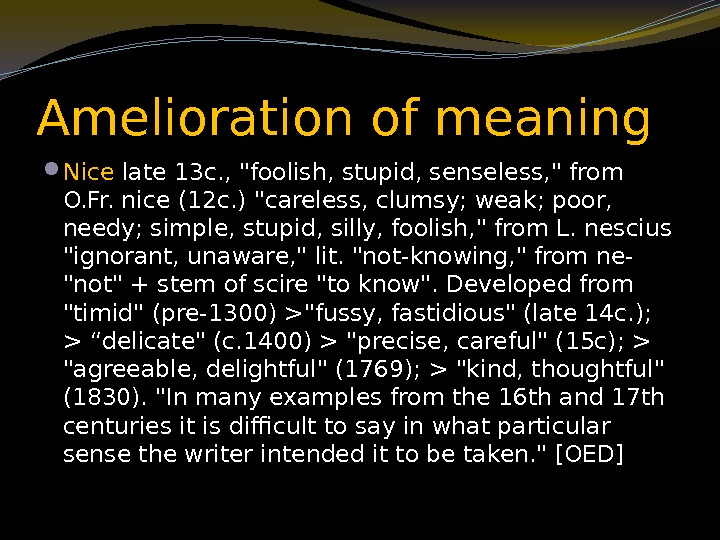
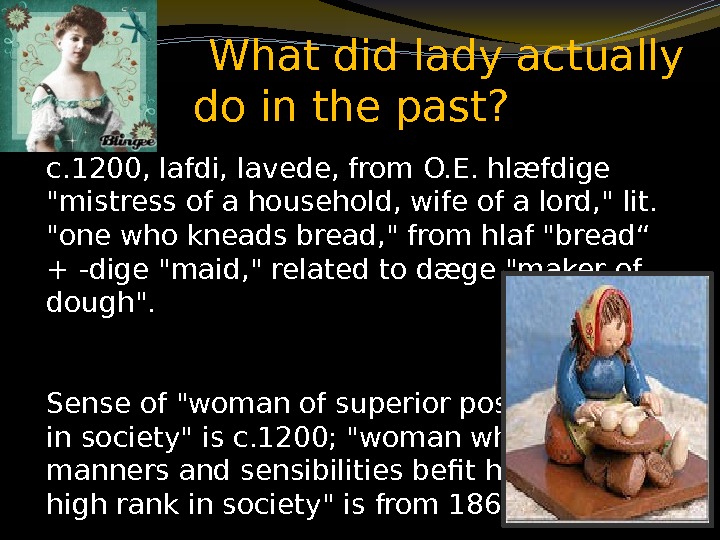
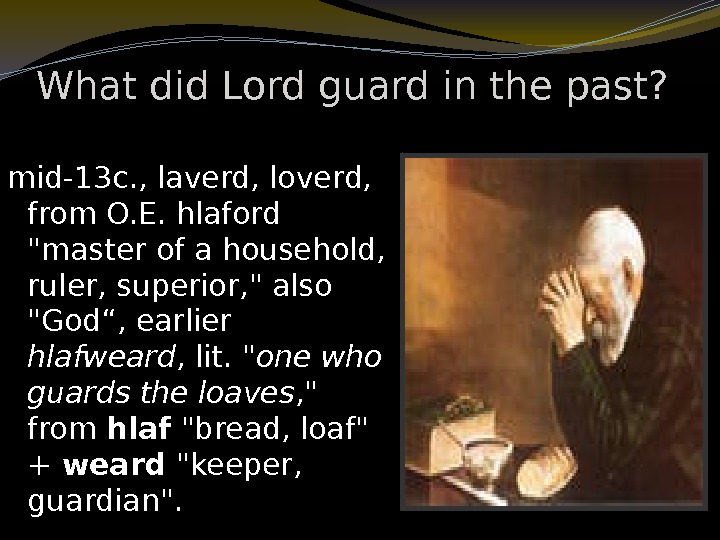
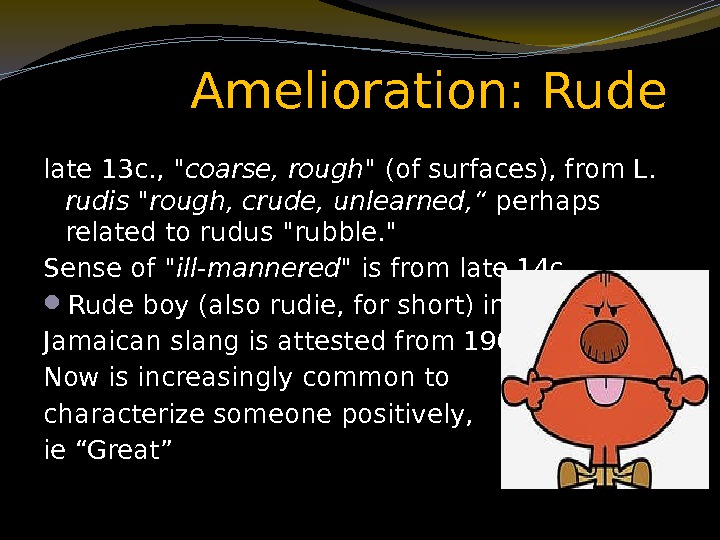
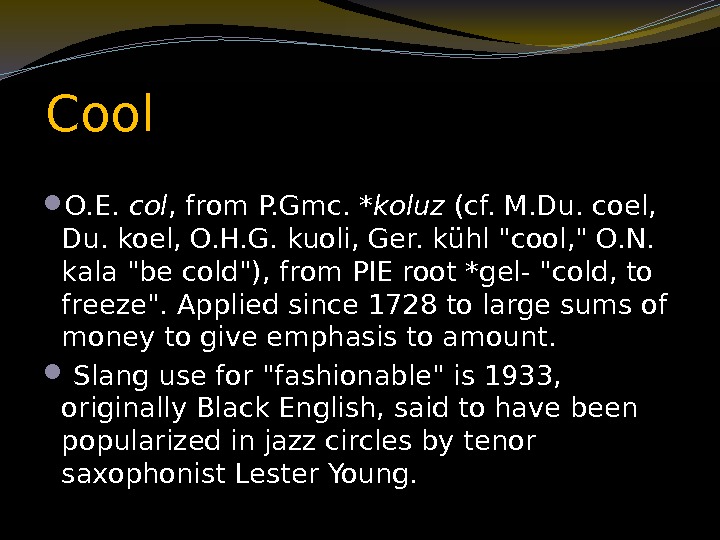
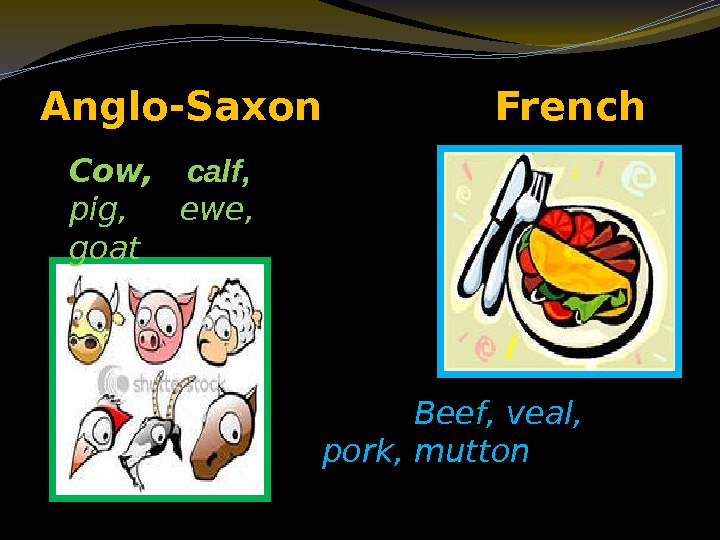
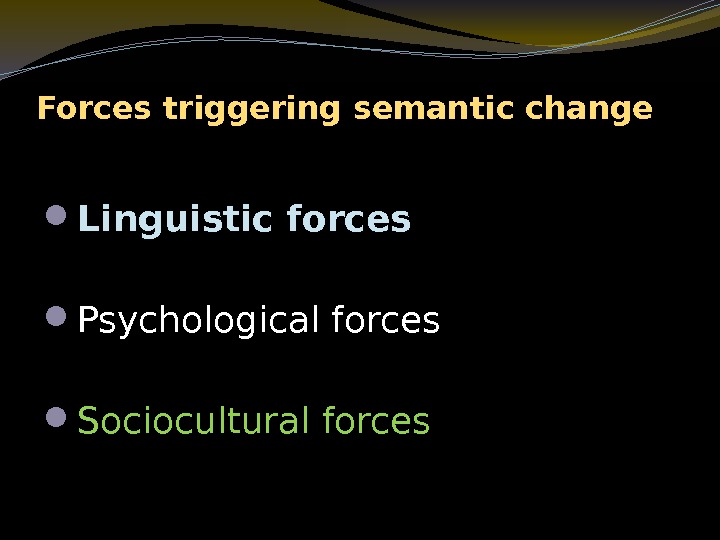
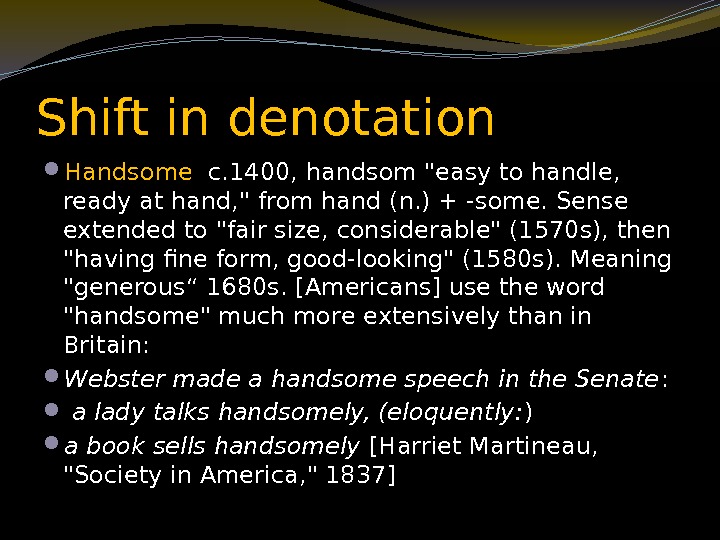
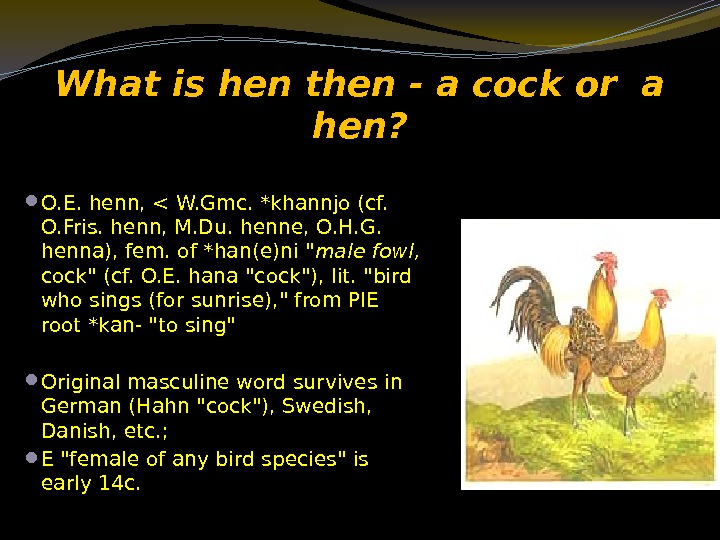
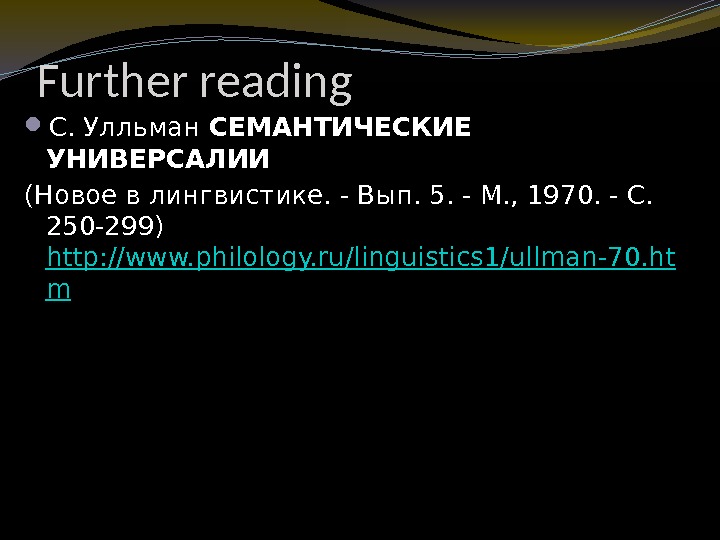

germ_4_1.pptx
- Размер: 837.3 Кб
- Автор:
- Количество слайдов: 84
Описание презентации The Germanic languages Alphabets, Vocabula ry and semantics по слайдам
 The Germanic languages Alphabets, Vocabula ry and semantics Lecture
The Germanic languages Alphabets, Vocabula ry and semantics Lecture
 Germanic alphabets
Germanic alphabets
 Types of alphabets Non-phonologically based Pictographic Egyptian, Messopotamian (3000 BC), Chinese (1500 BC) Ideographic (c. 2500 -100 BC): Near East (Sumerian, Babylonian, Assyrian, Hittite, Egyptian) Logographic (China, Japan) Phonologically based Syllabarius Greece (1300 BC) Latin or Roman : western Europe Cyrillic alphabet eastern Europe Devanagari (Indian Sanskrit)
Types of alphabets Non-phonologically based Pictographic Egyptian, Messopotamian (3000 BC), Chinese (1500 BC) Ideographic (c. 2500 -100 BC): Near East (Sumerian, Babylonian, Assyrian, Hittite, Egyptian) Logographic (China, Japan) Phonologically based Syllabarius Greece (1300 BC) Latin or Roman : western Europe Cyrillic alphabet eastern Europe Devanagari (Indian Sanskrit)
 Sumerian ideographic writing
Sumerian ideographic writing
 Egyptian hieroglyphs
Egyptian hieroglyphs
 Germanic alphabets Runic (Gothic ‘runa’, O. Icelandic ‘runar’, OE ‘run’ = secret, secret talk) Gothic IV c Latin
Germanic alphabets Runic (Gothic ‘runa’, O. Icelandic ‘runar’, OE ‘run’ = secret, secret talk) Gothic IV c Latin
 Runic alphabet Futhark is a writing system of uncertain origin used by Germanic peoples of northern Europe, Britain, Scandinavia, and Iceland from about the 3 rd century to the 16 th or 17 th century AD.
Runic alphabet Futhark is a writing system of uncertain origin used by Germanic peoples of northern Europe, Britain, Scandinavia, and Iceland from about the 3 rd century to the 16 th or 17 th century AD.
 Runic alphabets three main varieties: Early, or Common, Germanic (Teutonic), used in northern Europe before about 800 AD; Anglo-Saxon, or Anglian , used in Britain from the 5 th or 6 th century to about the 12 th century ad; Nordic, or Scandinavian , used from the 8 th to about the 12 th or 13 th century ad in Scandinavia and Iceland.
Runic alphabets three main varieties: Early, or Common, Germanic (Teutonic), used in northern Europe before about 800 AD; Anglo-Saxon, or Anglian , used in Britain from the 5 th or 6 th century to about the 12 th century ad; Nordic, or Scandinavian , used from the 8 th to about the 12 th or 13 th century ad in Scandinavia and Iceland.
 Elder Futhark (150 -800)
Elder Futhark (150 -800)
 Facts about Futhark Type : C&V, phonologically based Origin : 1) the alphabet was probably created independently rather than evolving from another alphabet. 2) Runic writing was probably first used in southern Europe and was carried north by Germanic tribes. 3) the Runic alphabet is thought to have been modelled on the Latin and/or Etruscan alphabet. Shape: angular Territory : Europe chronology : c. 200 direction: early Runic inscriptions is variable. Later settled down into a left to right pattern
Facts about Futhark Type : C&V, phonologically based Origin : 1) the alphabet was probably created independently rather than evolving from another alphabet. 2) Runic writing was probably first used in southern Europe and was carried north by Germanic tribes. 3) the Runic alphabet is thought to have been modelled on the Latin and/or Etruscan alphabet. Shape: angular Territory : Europe chronology : c. 200 direction: early Runic inscriptions is variable. Later settled down into a left to right pattern
 Runic inscriptions c. 160 AD Vimose гребінець знайдений у Vimose острів Funen, Данія Harja = «army» or «warrior-troop”ріг з Галегуса (c. 400 AD) Tранслітерація : ek hlewagastir holtijar horna tawido Переклад I, Hlewagastir Holtson, horn made
Runic inscriptions c. 160 AD Vimose гребінець знайдений у Vimose острів Funen, Данія Harja = «army» or «warrior-troop”ріг з Галегуса (c. 400 AD) Tранслітерація : ek hlewagastir holtijar horna tawido Переклад I, Hlewagastir Holtson, horn made
 Anglo-Saxon Futhork
Anglo-Saxon Futhork
 Long-Branch Runes
Long-Branch Runes
 Marcommanic Runes
Marcommanic Runes
 Dalecarliean Runes
Dalecarliean Runes
 Lord’s prayer in Gothic writing style
Lord’s prayer in Gothic writing style
 Vocabulary– all the words contained in a language Germanic vocabulary Words of IE origin Common Germanic words Words of unattested origin Specific for a given language words Borrowed words
Vocabulary– all the words contained in a language Germanic vocabulary Words of IE origin Common Germanic words Words of unattested origin Specific for a given language words Borrowed words
 Germanic words of IE origin Family relations : Sanscr. mātar , Gr. mātēr, Lat. māter , укр. мати (матері), OE mōdor , Ger. Mutter Names of animals, plants, artefacts : Lat. piscis, Rus. пескарь, Goth. fisks, E. fish, Germ. Fisch; Rus. зерно, Lat. granum, Goth. kaurn, E. corn, Germ. Korn; рус. дом, Sanscr. domah, Gr. dōma, Lat. domus, Goth. timrjan будувати, E. timber лісоматеріали, Germ. Zimmer кімната, Parts of body : Sanscr. nāsā, Lat. nasus, укр. ніс, E. nose, Ger. Nase, Gr. kardíā, Lat. cor (cordis), укр. серце, Goth. hairto, E heart, Ger. Herz
Germanic words of IE origin Family relations : Sanscr. mātar , Gr. mātēr, Lat. māter , укр. мати (матері), OE mōdor , Ger. Mutter Names of animals, plants, artefacts : Lat. piscis, Rus. пескарь, Goth. fisks, E. fish, Germ. Fisch; Rus. зерно, Lat. granum, Goth. kaurn, E. corn, Germ. Korn; рус. дом, Sanscr. domah, Gr. dōma, Lat. domus, Goth. timrjan будувати, E. timber лісоматеріали, Germ. Zimmer кімната, Parts of body : Sanscr. nāsā, Lat. nasus, укр. ніс, E. nose, Ger. Nase, Gr. kardíā, Lat. cor (cordis), укр. серце, Goth. hairto, E heart, Ger. Herz
 Germanic words of IE origin Natural phenomena : Ukr. вода, Sanscr. udan, Gr. hydōr, Lat. Unda хвиля, Goth. wato, E. water, Germ. Wasser; укр. ніч, Sanscr. nakti, Gr. nyx, Lat. nox, Goth. nahts, OE niht, Ger. Nacht. Adjective ‘new’ укр. новий, скр. navas, греч. ne(w)os, лат. Novus Numerals Pronouns personal, demonstrative, interrogative, reflexive
Germanic words of IE origin Natural phenomena : Ukr. вода, Sanscr. udan, Gr. hydōr, Lat. Unda хвиля, Goth. wato, E. water, Germ. Wasser; укр. ніч, Sanscr. nakti, Gr. nyx, Lat. nox, Goth. nahts, OE niht, Ger. Nacht. Adjective ‘new’ укр. новий, скр. navas, греч. ne(w)os, лат. Novus Numerals Pronouns personal, demonstrative, interrogative, reflexive
 Germanic words proper (pre-Germanic substrat) Names of parts of the body : Goth. handus, OE. hand рука, OE. bān кістка Names of animals and plants : OE. fugol птах, OE. hors кінь, Goth. kalbō, OE cealf теля, Goth. laufs, OE. lēaf лист Natural phenomena, geographic notions : Goth. rign, OE regn, OE storm, Goth. saiws, NE sea (cf. IE mare болото, ставок), land, strand, mew (*maiwa вид чайки), eider, auk, seal, sturgeon, herring.
Germanic words proper (pre-Germanic substrat) Names of parts of the body : Goth. handus, OE. hand рука, OE. bān кістка Names of animals and plants : OE. fugol птах, OE. hors кінь, Goth. kalbō, OE cealf теля, Goth. laufs, OE. lēaf лист Natural phenomena, geographic notions : Goth. rign, OE regn, OE storm, Goth. saiws, NE sea (cf. IE mare болото, ставок), land, strand, mew (*maiwa вид чайки), eider, auk, seal, sturgeon, herring.
 Germanic words proper Specific lexics (isolated words) occurring only in separate Germanic languages. Goth. rohns двір, iumjō натовп, OE aglæca чудовисько, wlonc гордий, wlencan владарювати, NE girl, bad, Ger. krieg війна. A great deal of old Germanic words disappeared
Germanic words proper Specific lexics (isolated words) occurring only in separate Germanic languages. Goth. rohns двір, iumjō натовп, OE aglæca чудовисько, wlonc гордий, wlencan владарювати, NE girl, bad, Ger. krieg війна. A great deal of old Germanic words disappeared
 The OE vocabulary was almost purely Germanic, except for a small number of borrowings. Native OE words are subdivided into etymological layers coming from different historical periods. The three main layers in the native OE words are: Common IE words, Common Gmc words and Specifically OE words. Words belonging to the Common IE layer constitute the oldest part of the OE vocabulary.
The OE vocabulary was almost purely Germanic, except for a small number of borrowings. Native OE words are subdivided into etymological layers coming from different historical periods. The three main layers in the native OE words are: Common IE words, Common Gmc words and Specifically OE words. Words belonging to the Common IE layer constitute the oldest part of the OE vocabulary.
 Sources of OE borrowings Celtic and Latin. Very few Celtic loan-words in OE vocabulary: place-names (element «llan» ie «church» : Llan daff, Llan dovery, Llan duduo).
Sources of OE borrowings Celtic and Latin. Very few Celtic loan-words in OE vocabulary: place-names (element «llan» ie «church» : Llan daff, Llan dovery, Llan duduo).
 Latin borrowings in English Entered the English language at different stages of OE history. The first layer. Early OE borrowings from Latin indicate the new things and concepts learnt from the Romans: war, trade, agriculture, building and home life. The second layer of Latin borrowings refer to religion. Latin borrowings fall into two main groups: 1) pertaining to religion 2) connected with learning.
Latin borrowings in English Entered the English language at different stages of OE history. The first layer. Early OE borrowings from Latin indicate the new things and concepts learnt from the Romans: war, trade, agriculture, building and home life. The second layer of Latin borrowings refer to religion. Latin borrowings fall into two main groups: 1) pertaining to religion 2) connected with learning.
 Scandinavian borrowings Dialectally restricted; increased the range of language variation; The number of Scandinavian loan-words in the Northern dialects has always been higher than in the Midlands and in the South. Total number of Scandinavian borrowings in English is about 900; about 700 of them belong to Standard English.
Scandinavian borrowings Dialectally restricted; increased the range of language variation; The number of Scandinavian loan-words in the Northern dialects has always been higher than in the Midlands and in the South. Total number of Scandinavian borrowings in English is about 900; about 700 of them belong to Standard English.
 Middle English borrowings In ME > 500 words borrowed from Scandinavian and > 3500 words borrowed from French words: everyday life of the Norman ruling class, government, court, legal procedure, army, military life, religious, church items, names of town occupations and terms of art.
Middle English borrowings In ME > 500 words borrowed from Scandinavian and > 3500 words borrowed from French words: everyday life of the Norman ruling class, government, court, legal procedure, army, military life, religious, church items, names of town occupations and terms of art.
 Earth apples late 14 c. , from O. Fr. cocombre , from L. cucumerem (nom. cucumis), perhaps from a pre-Italic Mediterranean language. The Latin word also is the source of It. cocomero, Sp. cohombro, Port. Cogombro. Replaced O. E. eorþæppla (pl. ), lit. «earth-apples. “ Phrase cool as a cucumber (c. 1732) embodies ancient folk knowledge confirmed by science in 1970: inside of a field cucumber on a warm day is 20 degrees cooler than the air temperature.
Earth apples late 14 c. , from O. Fr. cocombre , from L. cucumerem (nom. cucumis), perhaps from a pre-Italic Mediterranean language. The Latin word also is the source of It. cocomero, Sp. cohombro, Port. Cogombro. Replaced O. E. eorþæppla (pl. ), lit. «earth-apples. “ Phrase cool as a cucumber (c. 1732) embodies ancient folk knowledge confirmed by science in 1970: inside of a field cucumber on a warm day is 20 degrees cooler than the air temperature.
 Ea replaced by river c. 1300, from O. Fr. riviere, from V. L. *riparia «riverbank, seashore, river» (cf. Sp. ribera, It. riviera), noun use of fem. of L. riparius «of a riverbank». The OE word was ea «river, » cognate with Goth. ahwa , L. aqua.
Ea replaced by river c. 1300, from O. Fr. riviere, from V. L. *riparia «riverbank, seashore, river» (cf. Sp. ribera, It. riviera), noun use of fem. of L. riparius «of a riverbank». The OE word was ea «river, » cognate with Goth. ahwa , L. aqua.
 Semantic change is the evolution of word usage — usually to the point that the modern meaning is radically different from the original usage. In diachronic (or historical) linguistics, semantic change is a change in one of the meanings of a word.
Semantic change is the evolution of word usage — usually to the point that the modern meaning is radically different from the original usage. In diachronic (or historical) linguistics, semantic change is a change in one of the meanings of a word.
![The unpredictability of semantic change [I]n the majority of cases semantic change is as The unpredictability of semantic change [I]n the majority of cases semantic change is as](http://present5.com/presentbyword/20161216/germ_4_1_images/germ_4_1_29.jpg) The unpredictability of semantic change «[I]n the majority of cases semantic change is as fuzzy, self-contradictory, and difficult to predict as lexical semantics itself. This is the reason that after initial claims that they will at long last successfully deal with semantics, just about all linguistic theories quickly return to business as usual and concentrate on the structural aspects of language, which are more systematic and therefore easier to deal with. » (Hans Henrich Hock and Brian D. Joseph, Language History, Language Change, and Language Relationship. Walter de Gruyter, 1996)
The unpredictability of semantic change «[I]n the majority of cases semantic change is as fuzzy, self-contradictory, and difficult to predict as lexical semantics itself. This is the reason that after initial claims that they will at long last successfully deal with semantics, just about all linguistic theories quickly return to business as usual and concentrate on the structural aspects of language, which are more systematic and therefore easier to deal with. » (Hans Henrich Hock and Brian D. Joseph, Language History, Language Change, and Language Relationship. Walter de Gruyter, 1996)
 Semantic change ( semantic shift , semantic progression or semantic drift ) is the evolution of word usage — usually to the point that the modern meaning is radically different from the original usage. In diachronic linguistics, semantic change is a change in one of the meanings of a word
Semantic change ( semantic shift , semantic progression or semantic drift ) is the evolution of word usage — usually to the point that the modern meaning is radically different from the original usage. In diachronic linguistics, semantic change is a change in one of the meanings of a word
 Semantic change A variety of senses and connotations of a word can be + added , — removed, altered over time, often to the extent that cognates across space and time have very different meanings. The study of semantic change can be seen as part of etymology, onomasiology, semasiology, and semantics.
Semantic change A variety of senses and connotations of a word can be + added , — removed, altered over time, often to the extent that cognates across space and time have very different meanings. The study of semantic change can be seen as part of etymology, onomasiology, semasiology, and semantics.
 Typology of semantic change
Typology of semantic change
 Typology by Paul (1880) Specialization : enlargement of single senses of a word’s meaning Specialization on a specific part of the contents : reduction of single senses of a word’s meaning Transfer on a notion linked to the based notion in a spatial, temporal, or causal way
Typology by Paul (1880) Specialization : enlargement of single senses of a word’s meaning Specialization on a specific part of the contents : reduction of single senses of a word’s meaning Transfer on a notion linked to the based notion in a spatial, temporal, or causal way
 Typology by A. Darmesteter (1887) Metaphor Metonymy Narrowing of meaning Widening of meaning The last two are defined as change between whole and part, which would today be rendered as synecdoche.
Typology by A. Darmesteter (1887) Metaphor Metonymy Narrowing of meaning Widening of meaning The last two are defined as change between whole and part, which would today be rendered as synecdoche.
 Typology by Bréal (1899) Restriction of sense : change from a general to a special meaning Enlargement of sense : change from a special to a general meaning Metaphor «Thickening» of sense : change from an abstract to a concrete meaning
Typology by Bréal (1899) Restriction of sense : change from a general to a special meaning Enlargement of sense : change from a special to a general meaning Metaphor «Thickening» of sense : change from an abstract to a concrete meaning
 Typology by Ullmann distinguishes between nature and consequences of semantic change: Nature of semantic change Metaphor: change based on a similarity of senses Metonymy: change based on a contiguity of senses Folk-etymology: change based on a similarity of names Ellipsis: change based on a contiguity of names Consequences of semantic change Widening of meaning: raise of quantity Narrowing of meaning: loss of quantity Amelioration of meaning: raise of quality Pejoration of meaning: loss of quality
Typology by Ullmann distinguishes between nature and consequences of semantic change: Nature of semantic change Metaphor: change based on a similarity of senses Metonymy: change based on a contiguity of senses Folk-etymology: change based on a similarity of names Ellipsis: change based on a contiguity of names Consequences of semantic change Widening of meaning: raise of quantity Narrowing of meaning: loss of quantity Amelioration of meaning: raise of quality Pejoration of meaning: loss of quality
 Types of semantic change Narrowing Widening Metaphor Metonymy Synecdoche Hyperbole Meiosis Degeneration Elevation Leonard Bloomfield
Types of semantic change Narrowing Widening Metaphor Metonymy Synecdoche Hyperbole Meiosis Degeneration Elevation Leonard Bloomfield
 Narrowing Change from superordinate level to subordinate level. skyline formerly referred to any horizon, but now in the USA it has narrowed to a horizon decorated by skyscrapers
Narrowing Change from superordinate level to subordinate level. skyline formerly referred to any horizon, but now in the USA it has narrowed to a horizon decorated by skyscrapers
 — Are all birds fowls? — They seemed to be. Fowl O. E. fugel «bird, » representing the general Germanic word for them, from P. Gmc. *foglaz (cf. O. Fris. fugel, O. N. fugl, M. Du. voghel, Du. vogel, Ger. vogel, Goth. fugls), probably by dissimilation from *flug-la-, lit. «flyer, » from the same root as O. E. fleogan, modern fly. Originally «bird; » narrower sense of «domestic hen or rooster» is first recorded 1570 s. Narrowing
— Are all birds fowls? — They seemed to be. Fowl O. E. fugel «bird, » representing the general Germanic word for them, from P. Gmc. *foglaz (cf. O. Fris. fugel, O. N. fugl, M. Du. voghel, Du. vogel, Ger. vogel, Goth. fugls), probably by dissimilation from *flug-la-, lit. «flyer, » from the same root as O. E. fleogan, modern fly. Originally «bird; » narrower sense of «domestic hen or rooster» is first recorded 1570 s. Narrowing
 Where do you exactly go when you go to sea? Hmm… E. sæ «sheet of water, sea, lake , » from P. Gmc. * saiwaz (cf. O. S. seo , O. Fris. se , Du. see ), of unknown origin, outside connections «wholly doubtful“. Germanic languages use the general IE word (in English mere ), but have no firm distinction between » sea » and » lake , » either by size or by salt vs. fresh. The two words are used more or less interchangeably, and exist in opposite senses (e. g. Goth. saiws «lake, » marei «sea; » but Du. zee «sea, » meer «lake»). Cf. O. N. sær «sea, “ Dan. sø, usually «lake» but «sea» in phrases. Ger. See is «sea» (fem. ) or «lake» (masc. ).
Where do you exactly go when you go to sea? Hmm… E. sæ «sheet of water, sea, lake , » from P. Gmc. * saiwaz (cf. O. S. seo , O. Fris. se , Du. see ), of unknown origin, outside connections «wholly doubtful“. Germanic languages use the general IE word (in English mere ), but have no firm distinction between » sea » and » lake , » either by size or by salt vs. fresh. The two words are used more or less interchangeably, and exist in opposite senses (e. g. Goth. saiws «lake, » marei «sea; » but Du. zee «sea, » meer «lake»). Cf. O. N. sær «sea, “ Dan. sø, usually «lake» but «sea» in phrases. Ger. See is «sea» (fem. ) or «lake» (masc. ).
 Maid: HE or SHE? Maid late 12 c. , » a virgin, a young unmarried woman, » shortening of maiden (n. ). In ME used of unmarried men as well as women (c. 1200, used of both sexes, reflecting also the generic use of man).
Maid: HE or SHE? Maid late 12 c. , » a virgin, a young unmarried woman, » shortening of maiden (n. ). In ME used of unmarried men as well as women (c. 1200, used of both sexes, reflecting also the generic use of man).
 Mouse O. E. mus «small rodent, » also «muscle of the arm, » from P. Gmc. *mus (cf. O. N. , O. Fris. , M. Du. , Dan. , Swed. mus, Du. muis, Ger. Maus «mouse»), from PIE *mus- (cf. Skt. mus «mouse, rat). Narrowing Metaphor Computer sense is from 1965, though applied to other things resembling a mouse in shape since 1750, mainly nautical.
Mouse O. E. mus «small rodent, » also «muscle of the arm, » from P. Gmc. *mus (cf. O. N. , O. Fris. , M. Du. , Dan. , Swed. mus, Du. muis, Ger. Maus «mouse»), from PIE *mus- (cf. Skt. mus «mouse, rat). Narrowing Metaphor Computer sense is from 1965, though applied to other things resembling a mouse in shape since 1750, mainly nautical.
 Narrowing of meaning O. E. hund «dog, » from P. Gmc. *hundas (cf. O. S. , O. Fris. hund, O. H. G. hunt, Ger. Hund, O. N. hundr, Goth. hunds), from PIE *kuntos, dental enlargement of root *kwon- «dog». Meaning narrowed 12 c. to «dog used for hunting. «
Narrowing of meaning O. E. hund «dog, » from P. Gmc. *hundas (cf. O. S. , O. Fris. hund, O. H. G. hunt, Ger. Hund, O. N. hundr, Goth. hunds), from PIE *kuntos, dental enlargement of root *kwon- «dog». Meaning narrowed 12 c. to «dog used for hunting. «
 Food Meat O. E. foda «food, nourishment; fuel, » also figurative, from P. Gmc. *fodon (cf. Goth. fodeins), from Germanic root *fod-, equivalent of PIE *pa- «to tend, keep, pasture, to protect, to guard, to feed» (cf. Gk. pateisthai «to feed; » L. pabulum «food, fodder, » panis «bread, » pasci «to feed, » pascare «to graze, pasture, feed, » pastor «shepherd, » lit. «feeder; » Avestan pitu- «food; » O. C. S. pasti «feed cattle, pasture; » Rus. pishcha «food»). O. E. mete «food, item of food» (paired with drink), from P. Gmc. *mati (cf. O. Fris. mete, O. S. meti, O. N. matr, O. H. G. maz, Goth. mats «food, » M. Du. , Du. metworst, Ger. Mettwurst «type of sausage»), from PIE *mad-i-, from root *mad- «moist, wet, » also with reference to food qualities, (cf. Skt. medas- «fat» (n. ), O. Ir. mat «pig» Narrower sense of «flesh used as food» is first attested c. 1300.
Food Meat O. E. foda «food, nourishment; fuel, » also figurative, from P. Gmc. *fodon (cf. Goth. fodeins), from Germanic root *fod-, equivalent of PIE *pa- «to tend, keep, pasture, to protect, to guard, to feed» (cf. Gk. pateisthai «to feed; » L. pabulum «food, fodder, » panis «bread, » pasci «to feed, » pascare «to graze, pasture, feed, » pastor «shepherd, » lit. «feeder; » Avestan pitu- «food; » O. C. S. pasti «feed cattle, pasture; » Rus. pishcha «food»). O. E. mete «food, item of food» (paired with drink), from P. Gmc. *mati (cf. O. Fris. mete, O. S. meti, O. N. matr, O. H. G. maz, Goth. mats «food, » M. Du. , Du. metworst, Ger. Mettwurst «type of sausage»), from PIE *mad-i-, from root *mad- «moist, wet, » also with reference to food qualities, (cf. Skt. medas- «fat» (n. ), O. Ir. mat «pig» Narrower sense of «flesh used as food» is first attested c. 1300.
 Meat = food? Narrowing
Meat = food? Narrowing
 Fruit or vegetable? Narrowing Fruit late 12 c. , from O. Fr. fruit «fruit, fruit eaten as dessert; harvest; virtuous action» (12 c. ), from L. fructus «an enjoyment, delight, satisfaction; proceeds, produce, fruit, crops, » from frug-, stem of frui «to use, enjoy, » from PIE *bhrug- «agricultural produce, “ also «to enjoy“. Originally in English meaning vegetables as well.
Fruit or vegetable? Narrowing Fruit late 12 c. , from O. Fr. fruit «fruit, fruit eaten as dessert; harvest; virtuous action» (12 c. ), from L. fructus «an enjoyment, delight, satisfaction; proceeds, produce, fruit, crops, » from frug-, stem of frui «to use, enjoy, » from PIE *bhrug- «agricultural produce, “ also «to enjoy“. Originally in English meaning vegetables as well.
 Lake: what the hell is it? «body of water, » early 12 c. , from O. Fr. lack and directly from L. lacus «pond, lake, » also «basin, tank, » related to lacuna «hole, pit, » from PIE *laku- (cf. Gk. lakkos «pit, tank, pond, “ O. Ir. loch «lake, pond»). The common notion is «basin. » There was a Germanic form of the word, which yielded cognate O. N. lögr «sea flood, water, » O. E. lacu «stream, » lagu «sea flood, water, » leccan «to moisten“. In ME, lake, as a descendant of the OE word, also could mean «stream; river gully; ditch; marsh; grave; pit of hell, » and this might have influenced the form of the borrowed word. narrowing
Lake: what the hell is it? «body of water, » early 12 c. , from O. Fr. lack and directly from L. lacus «pond, lake, » also «basin, tank, » related to lacuna «hole, pit, » from PIE *laku- (cf. Gk. lakkos «pit, tank, pond, “ O. Ir. loch «lake, pond»). The common notion is «basin. » There was a Germanic form of the word, which yielded cognate O. N. lögr «sea flood, water, » O. E. lacu «stream, » lagu «sea flood, water, » leccan «to moisten“. In ME, lake, as a descendant of the OE word, also could mean «stream; river gully; ditch; marsh; grave; pit of hell, » and this might have influenced the form of the borrowed word. narrowing
 Country: shift and narrowing mid-13 c. , «district, native land, » from O. Fr. contree, from V. L. *(terra) contrata «(land) lying opposite, » or «(land) spread before one, » from L. contra «opposite, against». Sense narrowed 1520 s to rural areas, as opposed to cities. Replaced O. E. land.
Country: shift and narrowing mid-13 c. , «district, native land, » from O. Fr. contree, from V. L. *(terra) contrata «(land) lying opposite, » or «(land) spread before one, » from L. contra «opposite, against». Sense narrowed 1520 s to rural areas, as opposed to cities. Replaced O. E. land.
 What was spinster busy with? mid-14 c. , «female spinner of thread, » from M. E. spinnen + -stere , feminine suffix. Spinning commonly done by unmarried women > word came to denote «an unmarried woman“ (1600 s -1900 s), by 1719 was being used generically for «woman still unmarried and beyond the usual age for it”.
What was spinster busy with? mid-14 c. , «female spinner of thread, » from M. E. spinnen + -stere , feminine suffix. Spinning commonly done by unmarried women > word came to denote «an unmarried woman“ (1600 s -1900 s), by 1719 was being used generically for «woman still unmarried and beyond the usual age for it”.
 Soil: folk etymology, narrowing «the earth or ground, » c. 1300, from Anglo-Fr. soil «piece of ground, place» (13 c. ), from L. solium «seat, » meaning confused with that of L. solum «soil, ground. » Meaning «mould, earth, dirt» (especially that which plants grow in) is attested from mid-15 c.
Soil: folk etymology, narrowing «the earth or ground, » c. 1300, from Anglo-Fr. soil «piece of ground, place» (13 c. ), from L. solium «seat, » meaning confused with that of L. solum «soil, ground. » Meaning «mould, earth, dirt» (especially that which plants grow in) is attested from mid-15 c.
 Widening There are many examples of specific brand names being used for the general product, such as with Kleenex. Such uses are known as generonyms
Widening There are many examples of specific brand names being used for the general product, such as with Kleenex. Such uses are known as generonyms
 Widening of meaning O. E. macian «to make, form, construct, do; prepare, arrange, cause; behave, fare, transform, » from W. Gmc. *makon «to fashion, fit» (cf. O. S. makon, O. Fris. makia «to build, make, » M. Du. , Du. maken, O. H. G. mahhon «to construct, make, » Ger. machen «to make»), from PIE *mag- «to knead, mix; to fashion, fit». If so, sense evolution perhaps is via prehistoric houses built of mud. Gradually replaced the main OE word, gewyrcan.
Widening of meaning O. E. macian «to make, form, construct, do; prepare, arrange, cause; behave, fare, transform, » from W. Gmc. *makon «to fashion, fit» (cf. O. S. makon, O. Fris. makia «to build, make, » M. Du. , Du. maken, O. H. G. mahhon «to construct, make, » Ger. machen «to make»), from PIE *mag- «to knead, mix; to fashion, fit». If so, sense evolution perhaps is via prehistoric houses built of mud. Gradually replaced the main OE word, gewyrcan.
 Goat: He or She? (widening) O. E. gat «she-goat, » from P. Gmc. *gaitaz (cf. O. S. get, O. N. geit, Dan. gjed, M. Du. gheet, Du. geit, O. H. G. geiz, Ger. Geiß, Goth. gaits «goat»), from PIE *ghaidos «young goat, » also «play» (cf. L. hædus «kid»). The word for «male goat» in OE was bucca until late 1300 s shift to he- goat, she-goat (Nanny goat is 18 c. , billy goat 19 c. ).
Goat: He or She? (widening) O. E. gat «she-goat, » from P. Gmc. *gaitaz (cf. O. S. get, O. N. geit, Dan. gjed, M. Du. gheet, Du. geit, O. H. G. geiz, Ger. Geiß, Goth. gaits «goat»), from PIE *ghaidos «young goat, » also «play» (cf. L. hædus «kid»). The word for «male goat» in OE was bucca until late 1300 s shift to he- goat, she-goat (Nanny goat is 18 c. , billy goat 19 c. ).
 Widening: Tree O. E. treo, treow «tree» (also «wood»), from P. Gmc. *trewan (cf. O. Fris. tre, O. S. trio, O. N. tre, Goth. triu), from PIE *deru- «oak» (cf. Skt. dru «tree, wood, » daru «wood, log; » Gk. drys «oak, » doru «spear; » O. C. S. drievo «tree, wood; » Serb. drvo «tree, » drva «wood; » Rus. drevo «tree, wood; » Czech drva; Pol. drwa «wood; » Lith. derva «pine wood; » O. Ir. daur, Welsh derwen «oak, » Albanian drusk «oak»). Importance of the oak in mythology is reflected in the recurring use of words for «oak» to mean «tree. » In OE and ME, also «thing made of wood, » especially the cross of the Crucifixion and a gallows
Widening: Tree O. E. treo, treow «tree» (also «wood»), from P. Gmc. *trewan (cf. O. Fris. tre, O. S. trio, O. N. tre, Goth. triu), from PIE *deru- «oak» (cf. Skt. dru «tree, wood, » daru «wood, log; » Gk. drys «oak, » doru «spear; » O. C. S. drievo «tree, wood; » Serb. drvo «tree, » drva «wood; » Rus. drevo «tree, wood; » Czech drva; Pol. drwa «wood; » Lith. derva «pine wood; » O. Ir. daur, Welsh derwen «oak, » Albanian drusk «oak»). Importance of the oak in mythology is reflected in the recurring use of words for «oak» to mean «tree. » In OE and ME, also «thing made of wood, » especially the cross of the Crucifixion and a gallows
 — Are all birds fowls? — They seemed to be. O. E. bird , rare collateral form of bridd, originally «young bird, nestling» (the usual O. E. for «bird» being fugol), of uncertain origin with no cognates in any other Germanic language. Widening
— Are all birds fowls? — They seemed to be. O. E. bird , rare collateral form of bridd, originally «young bird, nestling» (the usual O. E. for «bird» being fugol), of uncertain origin with no cognates in any other Germanic language. Widening

 Metaphor Change based on similarity of thing.
Metaphor Change based on similarity of thing.
 Clouds in the sky O. E. clud » mass of rock, » related to clod. O. E. word for » cloud » was weolcan. In ME, skie also originally meant » cloud. “
Clouds in the sky O. E. clud » mass of rock, » related to clod. O. E. word for » cloud » was weolcan. In ME, skie also originally meant » cloud. “
 Clever late 16 c. , «handy, dexterous , » from E. Anglian dialectal cliver «expert at seizing , » perhaps from E. Fris. klufer or Norwegian dialectic klover «ready, skillful, » and perhaps influenced by O. E. clifer «claw, hand» (early usages seem to refer to dexterity); extension to intellect is first recorded 1704. This is a low word, scarcely ever used but in burlesque or conversation; and applied to any thing a man likes, without a settled meaning. [Johnson, 1755]
Clever late 16 c. , «handy, dexterous , » from E. Anglian dialectal cliver «expert at seizing , » perhaps from E. Fris. klufer or Norwegian dialectic klover «ready, skillful, » and perhaps influenced by O. E. clifer «claw, hand» (early usages seem to refer to dexterity); extension to intellect is first recorded 1704. This is a low word, scarcely ever used but in burlesque or conversation; and applied to any thing a man likes, without a settled meaning. [Johnson, 1755]
 Metonymy Change based on nearness in space or time, e. g. , jaw «cheek» → «mandible».
Metonymy Change based on nearness in space or time, e. g. , jaw «cheek» → «mandible».
 Ground was deep under the sea O. E. grund «bottom, foundation, ground, surface of the earth, » especially «bottom of the sea» (a sense preserved in run aground), from P. G. *grundus, which seems to have meant «deep place» (cf. O. Fris. , O. S. , Dan. , Swed. grund, Du. grond, O. H. G. grunt, Ger. Grund «ground, soil, bottom; » O. N. grunn «a shallow place, » grund «field, plain, » grunnr «bottom»). No known cognates outside Germanic.
Ground was deep under the sea O. E. grund «bottom, foundation, ground, surface of the earth, » especially «bottom of the sea» (a sense preserved in run aground), from P. G. *grundus, which seems to have meant «deep place» (cf. O. Fris. , O. S. , Dan. , Swed. grund, Du. grond, O. H. G. grunt, Ger. Grund «ground, soil, bottom; » O. N. grunn «a shallow place, » grund «field, plain, » grunnr «bottom»). No known cognates outside Germanic.
 Synecdoche Change based on whole-part relation. The convention of using capital cities to represent countries or their governments is an example of this
Synecdoche Change based on whole-part relation. The convention of using capital cities to represent countries or their governments is an example of this
 Would airplanes have feathers? O. E. feðer «feather, » in plural, «wings, » from P. Gmc. *fethro (cf. O. S. fethara, O. N. fioþr, Swed. fjäder, M. Du. vedere, Du. veder, O. H. G. fedara, Ger. Feder), from PIE *pet-ra-, from root *pet-«to rush, to fly”
Would airplanes have feathers? O. E. feðer «feather, » in plural, «wings, » from P. Gmc. *fethro (cf. O. S. fethara, O. N. fioþr, Swed. fjäder, M. Du. vedere, Du. veder, O. H. G. fedara, Ger. Feder), from PIE *pet-ra-, from root *pet-«to rush, to fly”
 A loaf of bread late 13 c. , from O. E. hlaf «portion of bread baked in a mass of definite form, » from PG *khlaibuz (cf. O. N. hleifr, Swed. lev, O. Fris. hlef, O. H. G. hleib, Ger. Laib, Goth. hlaifs «bread, loaf»), of uncertain origin, perhaps connected to O. E. hlifian «to raise higher, tower, » on the notion of the bread rising as it bakes. O. E. bread «bit, crumb, morsel; bread, » cognate with O. N. brauð, Dan. brød, O. Fris. brad, M. Du. brot, Du. brood, Ger. Brot). The basic sense being not «cooked food» but «piece of food, » and the O E word deriving from a P. Gmc. *braudsmon- «fragments, bits“ OE breotan «to break in pieces») and being related to the root of break. By c. 1200 it had replaced the usual OE hlaf.
A loaf of bread late 13 c. , from O. E. hlaf «portion of bread baked in a mass of definite form, » from PG *khlaibuz (cf. O. N. hleifr, Swed. lev, O. Fris. hlef, O. H. G. hleib, Ger. Laib, Goth. hlaifs «bread, loaf»), of uncertain origin, perhaps connected to O. E. hlifian «to raise higher, tower, » on the notion of the bread rising as it bakes. O. E. bread «bit, crumb, morsel; bread, » cognate with O. N. brauð, Dan. brød, O. Fris. brad, M. Du. brot, Du. brood, Ger. Brot). The basic sense being not «cooked food» but «piece of food, » and the O E word deriving from a P. Gmc. *braudsmon- «fragments, bits“ OE breotan «to break in pieces») and being related to the root of break. By c. 1200 it had replaced the usual OE hlaf.
 Hyperbole Change from weaker to stronger meaning e. g. kill «torment» → «slaughter»
Hyperbole Change from weaker to stronger meaning e. g. kill «torment» → «slaughter»
 Assassin — drug addict? 1530 s (in Anglo-Latin from mid-13 c. ), via French and Italian, from Arabic hashishiyyin «hashish-users, » plural of hashishiyy, from hashish. A fanatical Ismaili Muslim sect of the time of the Crusades, under leadership of the «Old Man of the Mountains“, with a reputation for murdering opposing leaders after intoxicating themselves by eating hashish. The pl. suffix -in was mistaken in Europe for part of the word.
Assassin — drug addict? 1530 s (in Anglo-Latin from mid-13 c. ), via French and Italian, from Arabic hashishiyyin «hashish-users, » plural of hashishiyy, from hashish. A fanatical Ismaili Muslim sect of the time of the Crusades, under leadership of the «Old Man of the Mountains“, with a reputation for murdering opposing leaders after intoxicating themselves by eating hashish. The pl. suffix -in was mistaken in Europe for part of the word.
 Meiosis change from stronger to weaker meaning e. g. , astound «strike with thunder» → «surprise strongly»
Meiosis change from stronger to weaker meaning e. g. , astound «strike with thunder» → «surprise strongly»
 Smart late O. E. smeart «sharp, severe, stinging, » related to smeortan. «quick, active, clever» is attested from c. 1300, probably from the notion of «cutting» wit, words, etc. ; meaning «trim in attire» first attested 1718 In ref. to devices, «behaving as though guided by intelligence» (e. g. smart bomb) first attested 1972. Smarts «good sense, intelligence, “ 1968.
Smart late O. E. smeart «sharp, severe, stinging, » related to smeortan. «quick, active, clever» is attested from c. 1300, probably from the notion of «cutting» wit, words, etc. ; meaning «trim in attire» first attested 1718 In ref. to devices, «behaving as though guided by intelligence» (e. g. smart bomb) first attested 1972. Smarts «good sense, intelligence, “ 1968.
 Degeneration : e. g. , knave «boy» → «servant» → «deceitful or despicable man».
Degeneration : e. g. , knave «boy» → «servant» → «deceitful or despicable man».
 Examples of semantic change Awful originally «inspiring wonder (or fear)». O riginally a shortening for «full of awe» contemporary usage is of negative meaning.
Examples of semantic change Awful originally «inspiring wonder (or fear)». O riginally a shortening for «full of awe» contemporary usage is of negative meaning.
 Pejoration of meaning Silly O. E. gesælig «happy» (related to sæl «happiness»), from W. Gmc. *sæligas (cf. O. N. sæll «happy, » Goth. sels «good, kindhearted, » O. S. salig, M. Du. salich, O. H. G. salig, Ger. selig «blessed, happy, blissful»), from PIE root *sel- «happy». The word’s considerable sense development moved from «blessed» > «pious, » > «innocent» (c. 1200), > «harmless, » > «pitiable» (late 13 c. ), > «weak» (c. 1300), >»feeble in mind, lacking in reason, foolish» (1570 s). Further tendency toward «stunned, dazed as by a blow» (1886) in knocked silly, etc.
Pejoration of meaning Silly O. E. gesælig «happy» (related to sæl «happiness»), from W. Gmc. *sæligas (cf. O. N. sæll «happy, » Goth. sels «good, kindhearted, » O. S. salig, M. Du. salich, O. H. G. salig, Ger. selig «blessed, happy, blissful»), from PIE root *sel- «happy». The word’s considerable sense development moved from «blessed» > «pious, » > «innocent» (c. 1200), > «harmless, » > «pitiable» (late 13 c. ), > «weak» (c. 1300), >»feeble in mind, lacking in reason, foolish» (1570 s). Further tendency toward «stunned, dazed as by a blow» (1886) in knocked silly, etc.
 Elevation e. g. , knight «boy» → «nobleman».
Elevation e. g. , knight «boy» → «nobleman».
 Amelioration of meaning Nice late 13 c. , «foolish, stupid, senseless, » from O. Fr. nice (12 c. ) «careless, clumsy; weak; poor, needy; simple, stupid, silly, foolish, » from L. nescius «ignorant, unaware, » lit. «not-knowing, » from ne- «not» + stem of scire «to know». Developed from «timid» (pre-1300) >»fussy, fastidious» (late 14 c. ); > “delicate» (c. 1400) > «precise, careful» (15 c); > «agreeable, delightful» (1769); > «kind, thoughtful» (1830). «In many examples from the 16 th and 17 th centuries it is difficult to say in what particular sense the writer intended it to be taken. » [OED]
Amelioration of meaning Nice late 13 c. , «foolish, stupid, senseless, » from O. Fr. nice (12 c. ) «careless, clumsy; weak; poor, needy; simple, stupid, silly, foolish, » from L. nescius «ignorant, unaware, » lit. «not-knowing, » from ne- «not» + stem of scire «to know». Developed from «timid» (pre-1300) >»fussy, fastidious» (late 14 c. ); > “delicate» (c. 1400) > «precise, careful» (15 c); > «agreeable, delightful» (1769); > «kind, thoughtful» (1830). «In many examples from the 16 th and 17 th centuries it is difficult to say in what particular sense the writer intended it to be taken. » [OED]
 c. 1200, lafdi, lavede, from O. E. hlæfdige «mistress of a household, wife of a lord, » lit. «one who kneads bread, » from hlaf «bread“ + -dige «maid, » related to dæge «maker of dough». Sense of «woman of superior position in society» is c. 1200; «woman whose manners and sensibilities befit her for high rank in society» is from 1861 What did lady actually do in the past?
c. 1200, lafdi, lavede, from O. E. hlæfdige «mistress of a household, wife of a lord, » lit. «one who kneads bread, » from hlaf «bread“ + -dige «maid, » related to dæge «maker of dough». Sense of «woman of superior position in society» is c. 1200; «woman whose manners and sensibilities befit her for high rank in society» is from 1861 What did lady actually do in the past?
 What did Lord guard in the past? mid-13 c. , laverd, loverd, from O. E. hlaford «master of a household, ruler, superior, » also «God“, earlier hlafweard , lit. » one who guards the loaves , » from hlaf «bread, loaf» + weard «keeper, guardian».
What did Lord guard in the past? mid-13 c. , laverd, loverd, from O. E. hlaford «master of a household, ruler, superior, » also «God“, earlier hlafweard , lit. » one who guards the loaves , » from hlaf «bread, loaf» + weard «keeper, guardian».
 Amelioration: Rude late 13 c. , «coarse, rough» (of surfaces), from L. rudis «rough, crude, unlearned, “ perhaps related to rudus «rubble. » Sense of «ill-mannered» is from late 14 c. Rude boy (also rudie, for short) in Jamaican slang is attested from 1967. Now is increasingly common to characterize someone positively, ie “Great”
Amelioration: Rude late 13 c. , «coarse, rough» (of surfaces), from L. rudis «rough, crude, unlearned, “ perhaps related to rudus «rubble. » Sense of «ill-mannered» is from late 14 c. Rude boy (also rudie, for short) in Jamaican slang is attested from 1967. Now is increasingly common to characterize someone positively, ie “Great”
 Cool O. E. col , from P. Gmc. *koluz (cf. M. Du. coel, Du. koel, O. H. G. kuoli, Ger. kühl «cool, » O. N. kala «be cold»), from PIE root *gel- «cold, to freeze». Applied since 1728 to large sums of money to give emphasis to amount. Slang use for «fashionable» is 1933, originally Black English, said to have been popularized in jazz circles by tenor saxophonist Lester Young.
Cool O. E. col , from P. Gmc. *koluz (cf. M. Du. coel, Du. koel, O. H. G. kuoli, Ger. kühl «cool, » O. N. kala «be cold»), from PIE root *gel- «cold, to freeze». Applied since 1728 to large sums of money to give emphasis to amount. Slang use for «fashionable» is 1933, originally Black English, said to have been popularized in jazz circles by tenor saxophonist Lester Young.
 Anglo-Saxon French Cow, calf, pig, ewe, goat Beef, veal, pork, mutton
Anglo-Saxon French Cow, calf, pig, ewe, goat Beef, veal, pork, mutton
 Forces triggering semantic change Linguistic forces Psychological forces Sociocultural forces
Forces triggering semantic change Linguistic forces Psychological forces Sociocultural forces
 Shift in denotation Handsome c. 1400, handsom «easy to handle, ready at hand, » from hand (n. ) + -some. Sense extended to «fair size, considerable» (1570 s), then «having fine form, good-looking» (1580 s). Meaning «generous“ 1680 s. [Americans] use the word «handsome» much more extensively than in Britain: Webster made a handsome speech in the Senate : a lady talks handsomely, (eloquently: ) a book sells handsomely [Harriet Martineau, «Society in America, » 1837]
Shift in denotation Handsome c. 1400, handsom «easy to handle, ready at hand, » from hand (n. ) + -some. Sense extended to «fair size, considerable» (1570 s), then «having fine form, good-looking» (1580 s). Meaning «generous“ 1680 s. [Americans] use the word «handsome» much more extensively than in Britain: Webster made a handsome speech in the Senate : a lady talks handsomely, (eloquently: ) a book sells handsomely [Harriet Martineau, «Society in America, » 1837]
 What is hen then — a cock or a hen? O. E. henn, < W. Gmc. *khannjo (cf. O. Fris. henn, M. Du. henne, O. H. G. henna), fem. of *han(e)ni " male fowl, cock" (cf. O. E. hana "cock"), lit. "bird who sings (for sunrise), " from PIE root *kan- "to sing" Original masculine word survives in German (Hahn "cock"), Swedish, Danish, etc. ; E "female of any bird species" is early 14 c.
What is hen then — a cock or a hen? O. E. henn, < W. Gmc. *khannjo (cf. O. Fris. henn, M. Du. henne, O. H. G. henna), fem. of *han(e)ni " male fowl, cock" (cf. O. E. hana "cock"), lit. "bird who sings (for sunrise), " from PIE root *kan- "to sing" Original masculine word survives in German (Hahn "cock"), Swedish, Danish, etc. ; E "female of any bird species" is early 14 c.
 Further reading С. Улльман СЕМАНТИЧЕСКИЕ УНИВЕРСАЛИИ (Новое в лингвистике. — Вып. 5. — М. , 1970. — С. 250 -299) http: //www. philology. ru/linguistics 1/ullman-70. ht m
Further reading С. Улльман СЕМАНТИЧЕСКИЕ УНИВЕРСАЛИИ (Новое в лингвистике. — Вып. 5. — М. , 1970. — С. 250 -299) http: //www. philology. ru/linguistics 1/ullman-70. ht m
 Thank you for your attention!
Thank you for your attention!
